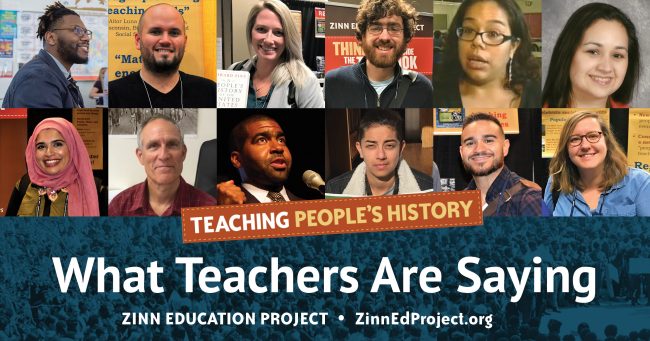
Here are just a few of the countless stories we have received from the more than 160,000 teachers who have accessed lessons from the Zinn Education Project website. They speak to the power of teaching people’s history. Add your teaching story.
As Corey Winchester says, “it invigorates students’ desire to learn and disrupt the status quo.”
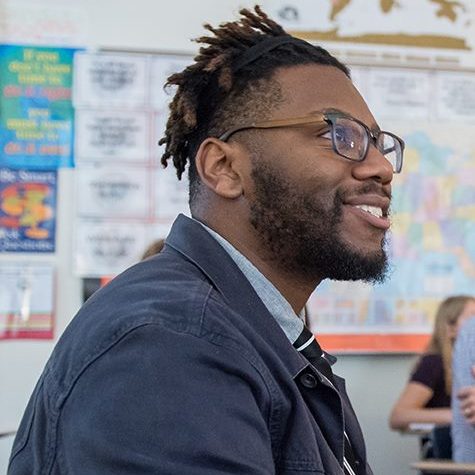
I’ve used the Zinn Education Project’s materials since my first year teaching.
Nine years later, my students can speak to the power of deconstructing the narratives of Christopher Columbus and Abraham Lincoln’s efforts that have replicated white supremacy and marginalization of people of color in historical discourse.
For many of them, it is empowering to learn from multiple perspectives and invigorates their desire to learn and disrupt the status quo.
View this post on Instagram
View this post on Instagram
View this post on Instagram
View this post on Instagram
Lena Amick in Baltimore describes the impact of teaching our popular People vs. Columbus lesson in the form of a trial.
I love how “the system of empire” is one of the options for students to blame or defend. This has generated some of the most challenging discussions I’ve seen in my class so far, as students say, “The king and queen would not have sent Columbus if they hadn’t been acting within the system!” and retort, “But the system is made up of individuals, and each have their own choices!” This thinking about structure vs. agency is a level of thinking in social studies that was not made explicit to me until college.
One of my students reflected, “I think that Columbus is like Trump, and the Tainos are like the Mexican people . . .” This prompted a discussion about how colonial-type oppression works in our current society.
Your resources truly fill a well left dry — not by forgetfulness, but by the same racist systems that perpetuate the injustices my students face on a daily basis in schools.
Teacher Contributors
For many teachers, the Zinn Education Project resources mean so much to them that they become contributors, including the three below. Join them with a donation.
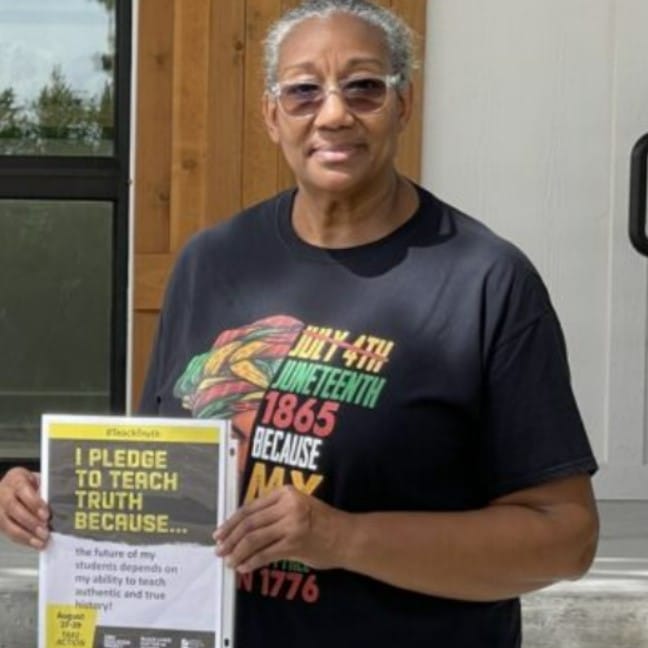
I am donating to the Zinn Education Project in honor of all the educators in my family. Especially my great-grandfather London Williams who contributed funding and land for Morris College, a HBCU in Sumter, South Carolina.
[Learn about Nelva Williamson’s history as an educator in this Storycorps segment.]
I’m donating to the Zinn Education Project as a U.S. History teacher who has benefited from the people’s history lessons and people’s history classes online. The lessons are amazing and get my students far more engaged than anything else. The online classes have also provided the opportunity to learn and collaborate in community with like-minded educators across the country who believe in teaching truth!
Finally, I’m donating in honor of my mother Catherine Billingsley, who died in 2017. She was a teacher for over 30 years in rural Arkansas. She believed in the power and importance of education her whole life and passed that belief to me. I’m proud to be teaching people’s history!
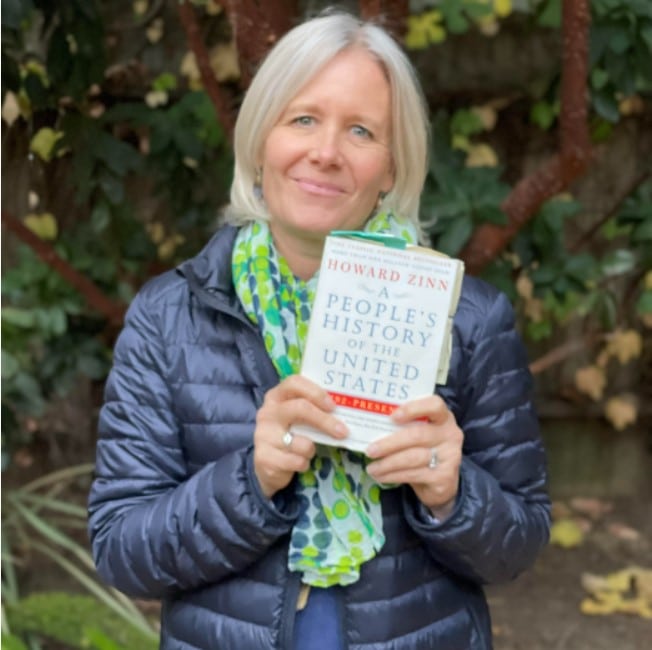
More than thirty years ago, I had the pleasure of sitting next to Howard Zinn on a cross-country flight to check out graduate programs. Despite my being somewhat star-struck, he was one of those easy to “fall into conversation with” seatmates — kind, engaging, and interested in why I was traveling.
When I revealed that I was considering becoming a social studies teacher, he said “You must do that. The world needs teachers like the one you will be.” The voice of the universe had spoken and I have been a classroom teacher for the past thirty years, using parts of A People’s History of the United States and his inspirational approach to understanding the American experience.
More Classroom Stories
Find many more classroom stories below.
 Teachers and students, please add your quotes and stories. We invite everyone to make a donation so that we can reach more teachers with these lessons.
Teachers and students, please add your quotes and stories. We invite everyone to make a donation so that we can reach more teachers with these lessons.
Jump to: People’s History Curriculum • Civil Rights Movement • Teaching Climate Justice • Abolition Movement and Resistance to Slavery • COINTELPRO • Teaching Reconstruction • The People vs. Columbus, et al. • The Constitutional Convention Role Play • U. S. – Mexico War • A People’s History of the United States • This Day in History series
People’s History Curriculum and Resources
These comments are about the overall impact of teaching people’s history and the Zinn Education Project resources. The sections that follow are about specific people’s history lessons.
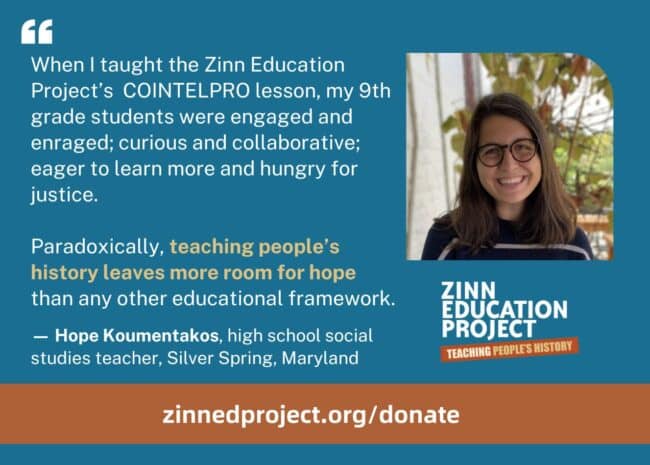
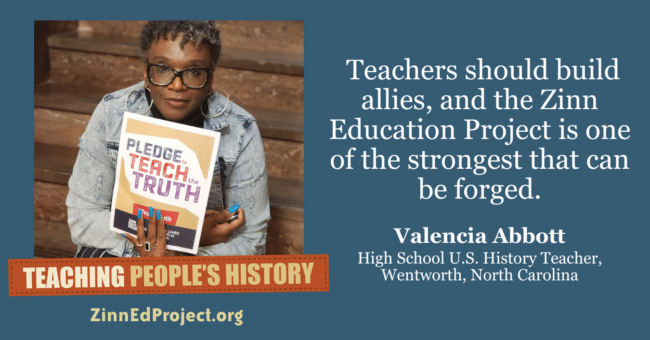
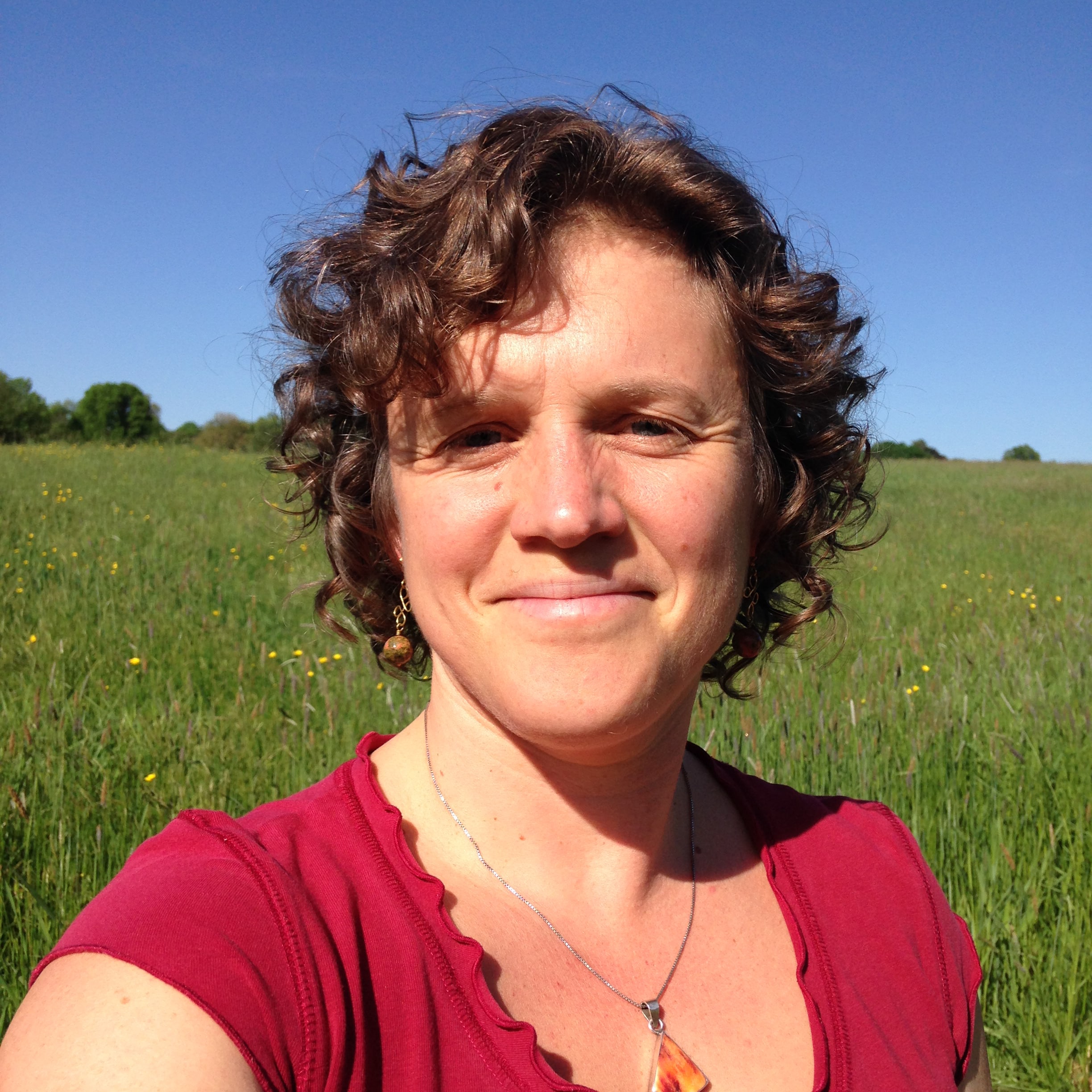
I use Howard Zinn’s seminal text, A People’s History of the United States, as well as resources from the Zinn Education Project, because they engage students well. I appreciate that the Zinn text posits provocative ideas which facilitate student engagement and excite students to debate ideas. By focusing on many of the ordinary people through history, students connect to ideas of justice and a history they often feel speaks truth to them. Zinn’s critical thinking and analysis helps students feel motivated to learn more.
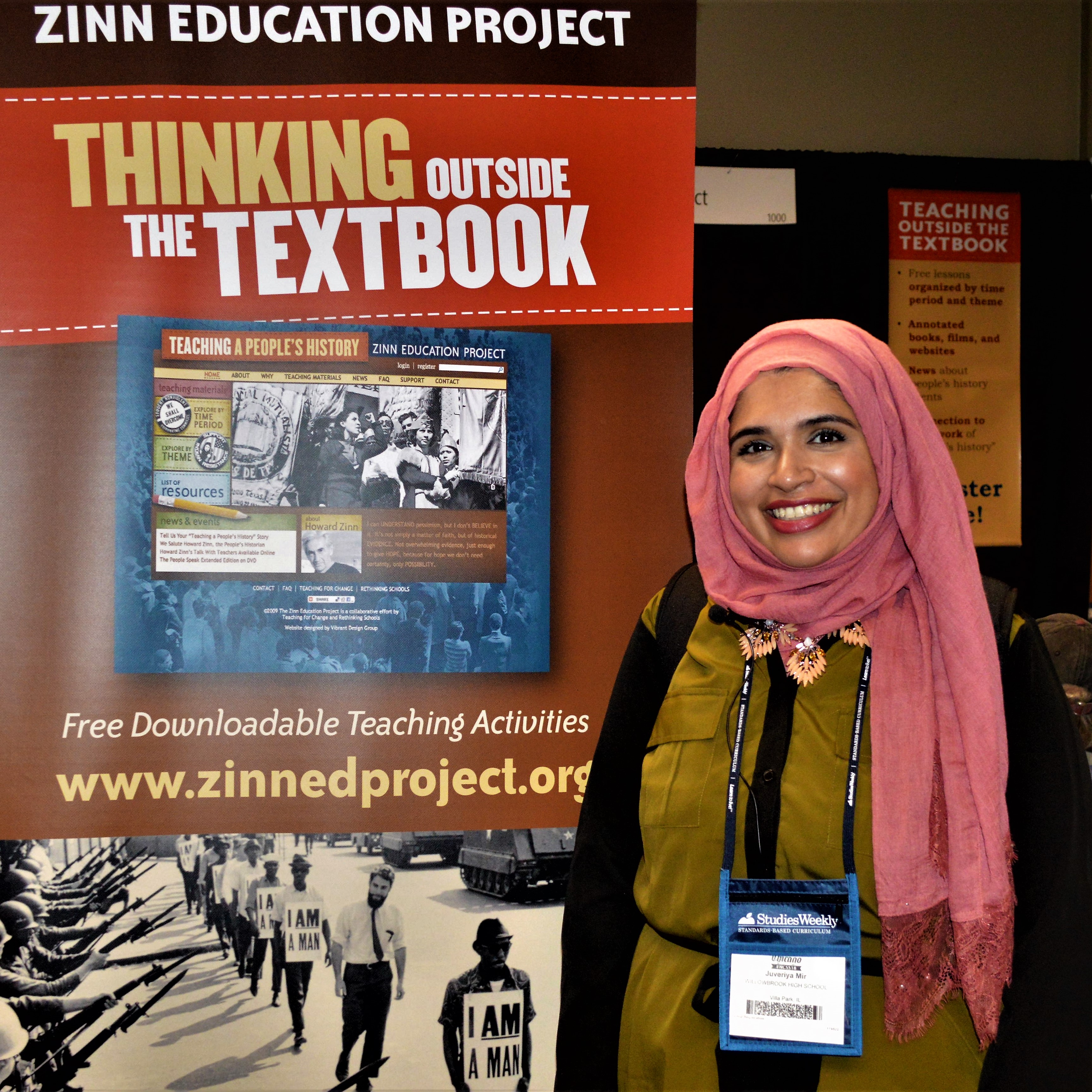
The Zinn Education Project helps me bring multiple perspectives in my classroom and allows me to teach history fairly and accurately. Our history is not perfect, it’s progress. We won’t move forward without understanding the full picture of our past.
Textbooks alone cannot provide that. Resources like the Zinn Education Project give us a window into the past that helps teachers explain the view from the shore and the view from the boat for example.
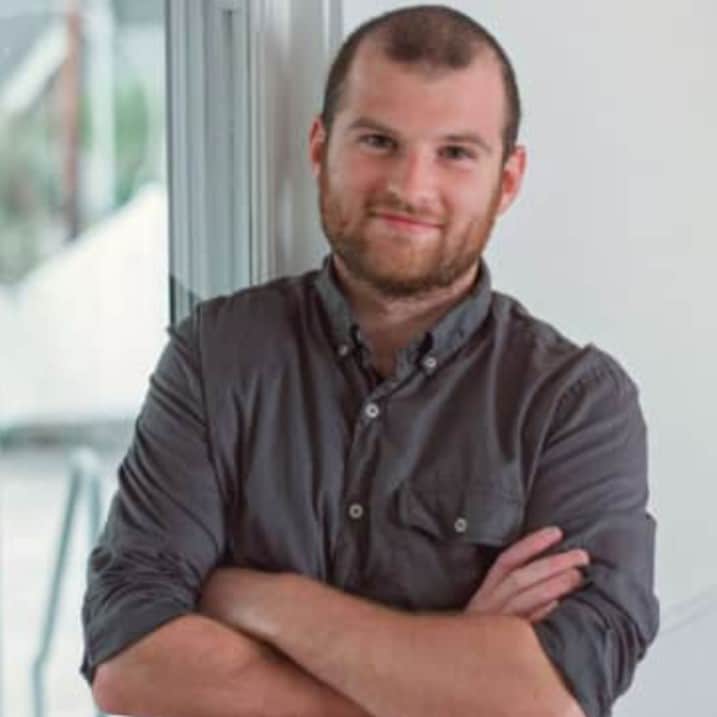
Three years ago I joined a Teaching for Black Lives study group and have been using the Stories from the Climate Crisis: A Mixer lesson and Reconstructing the South: A Role Play ever since. The lessons are engaging and have my students consider perspectives that they would not usually be exposed to. I was even able to take the Climate Change Mixer and use it to create similar assignments for other subjects or lessons that the students liked. In my experience, the Zinn Education Project encourages students to think and problem solve based on their own ability to reason. These valuable skills can carry beyond the classroom and help make for responsible citizens out in the world.
Furthermore, students have enjoyed reading Sugar, Half American, and Paradise on Fire. These stories add visibility and diversity to the classroom — something that is often hard to come by and hard to afford as a public education teacher. Anything and everything that the Zinn Education Project shares with a classroom is a vital component of that class going forward.
There’s no way I could be as effective in pushing students’ thinking and getting them to critically question the otherwise accepted narrative of history without the resources and ideas provided by the Zinn Education Project. It continues to push my own thinking of how to present and examine history.
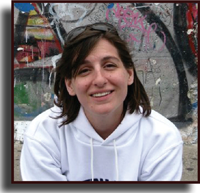
I thoroughly appreciate the range of material offered though the Zinn Education Project, Teaching for Change, and Rethinking Schools. These organizations and projects are helping me establish a curriculum centered on social justice that, as a first-year teacher, would have been so much more difficult to do without.
The Zinn Education Project is rich in primary sources that help me supplement my lessons.
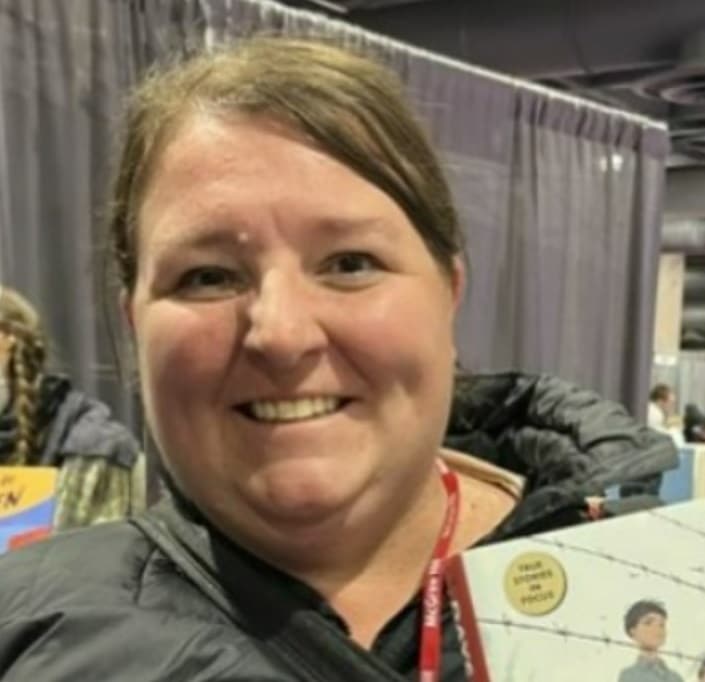
My students live in a rural, high poverty, homogenous town. They have generational beliefs that are often tough to crack. My goal with them is to give them all the information and let them decide how they are going to use it.
Students love Zinn Education Project lessons because they give a narrative of history that they have never heard before. They find them interesting and add a piece to the puzzle that is U.S. history.
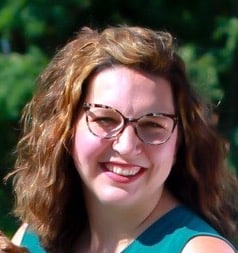
I always point my teacher candidates in the direction of the Zinn Education Project materials. They are honest, courageous, and necessary for powerful social studies learning.
In particular, I’m very grateful for the materials that explore labor history and environmental issues as high quality curriculum resources on these topics are hard to find.
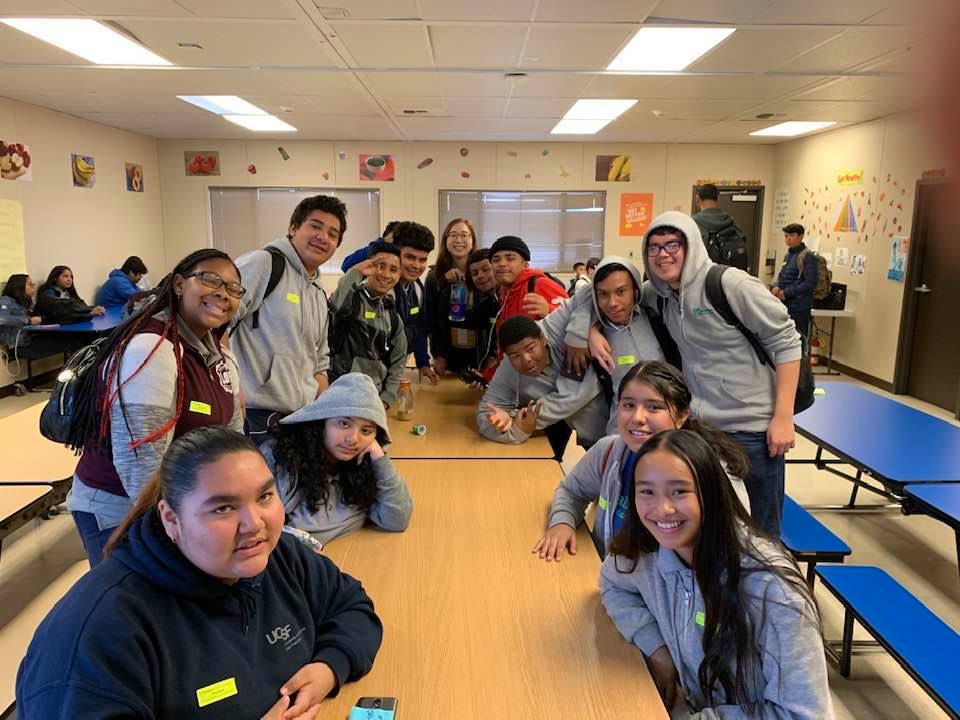
I have used the Zinn Education Project’s lessons almost weekly in my classroom! We began with a unit on Reconstruction, where we utilized the curriculum guides shared by Zinn. Not only was it academically rigorous and challenging for my students, but it reflected historical themes and questions they had always wondered about, but never learned about.
From reading the “Price of Paradise” on Hawaii’s colonization, to reading Vietnam’s Declaration of Independence from France and the U.S. entry into war, to engaging in the numerous simulations (my students’ favorite!) about historical events like segregation in How Red Lines Built White Wealth, the Zinn Education Project’s lessons continue to encourage my students to question the history they are taught in school.
They have learned not to take anything at face value, and they continue to take this level of questioning and critical thinking beyond the classroom. I am so thankful to Zinn to providing resources to me as an educator that speak to my students’ historical oppression and give them tangible ways to fight back against the sanitized versions of history given to them.
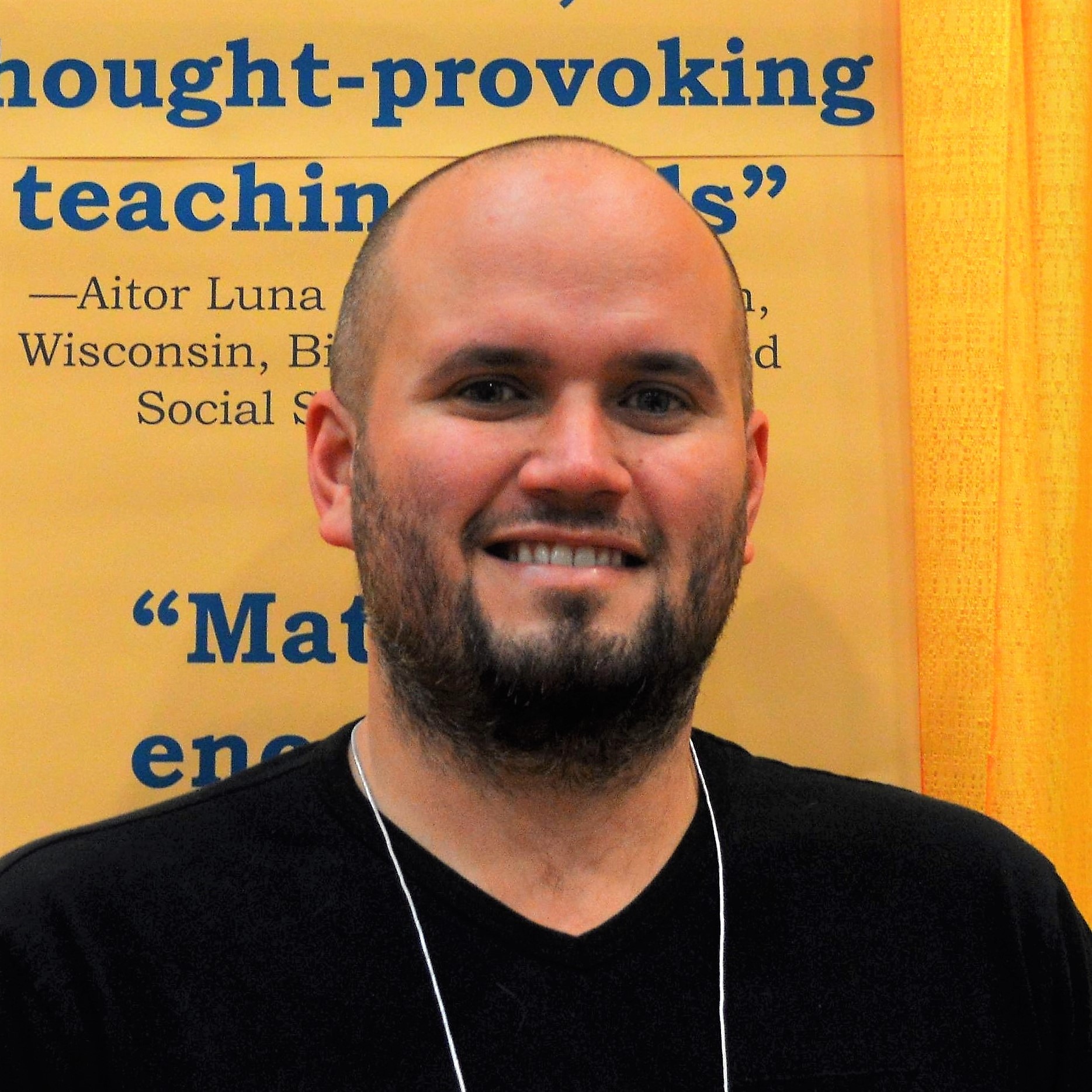
The Zinn Education Project is my compass in a sea of corporate textbooks, packaged common core curriculum, and standardized testing.
My entire curriculum is based on lessons that can be found on the Zinn Education Project.
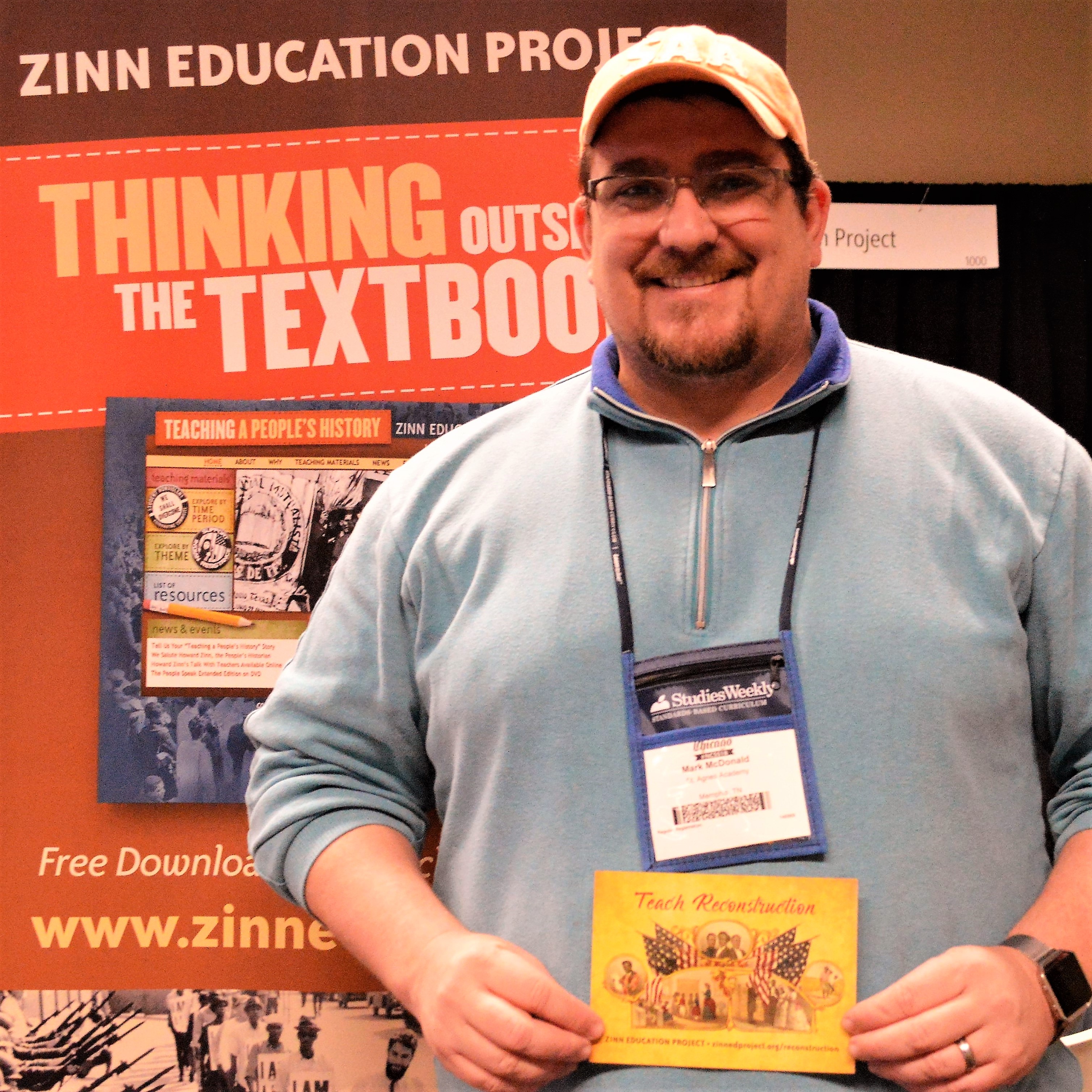
To the Zinn Education Project, I can only say thank you — thank you for insisting that we teach marginalized voices and time periods, for providing us key resources that make our jobs in the classroom easier, and for challenging us to always question the reasons behind the material we choose the teach.
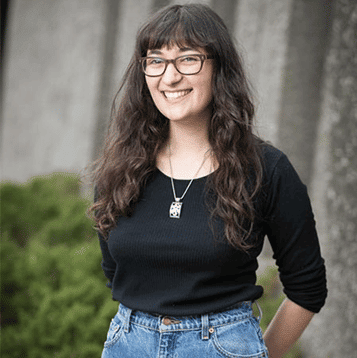
I use Zinn Education Project resources in my classroom all of the time! They allow me to infuse social justice throughout everything I do in an easy-to-manage way, which is everything to me in this wild pandemic time. Thank you for all that you do!
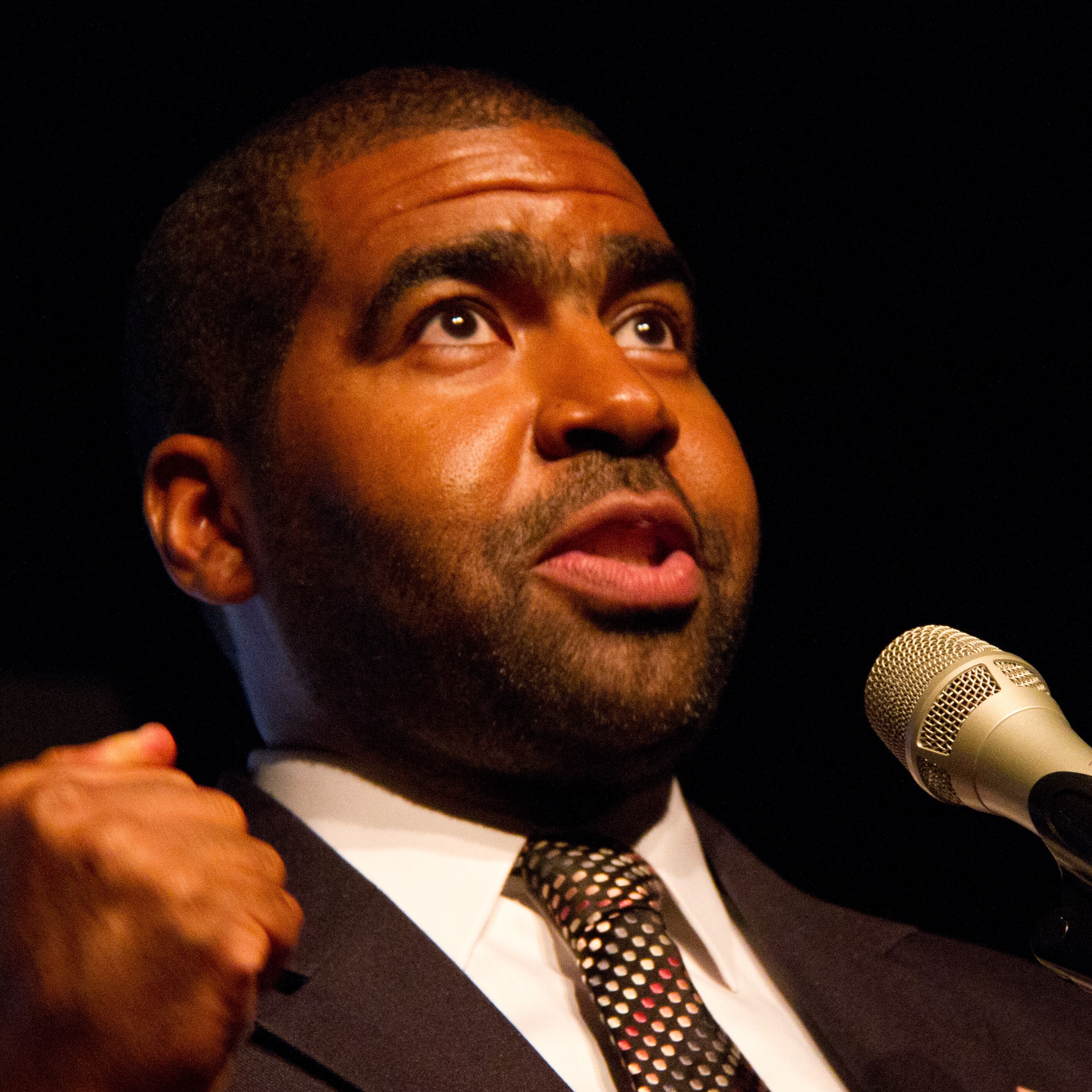
As a teacher, the Zinn Education Project website is invaluable because it provides activities that directly relate to A People’s History. Last week we did The People vs. Columbus, et al. which places all the parties involved in the arrival of Columbus on trial for the murder of the Tainos. The activity was so interactive that teachers from other classrooms had to ask us to quiet down. Students were able to better understand the motives and consequences behind the arrival.
Even though A People’s History can be a bit difficult for some students, the activities on the Zinn Education Project website makes the content accessible regardless of their reading level.
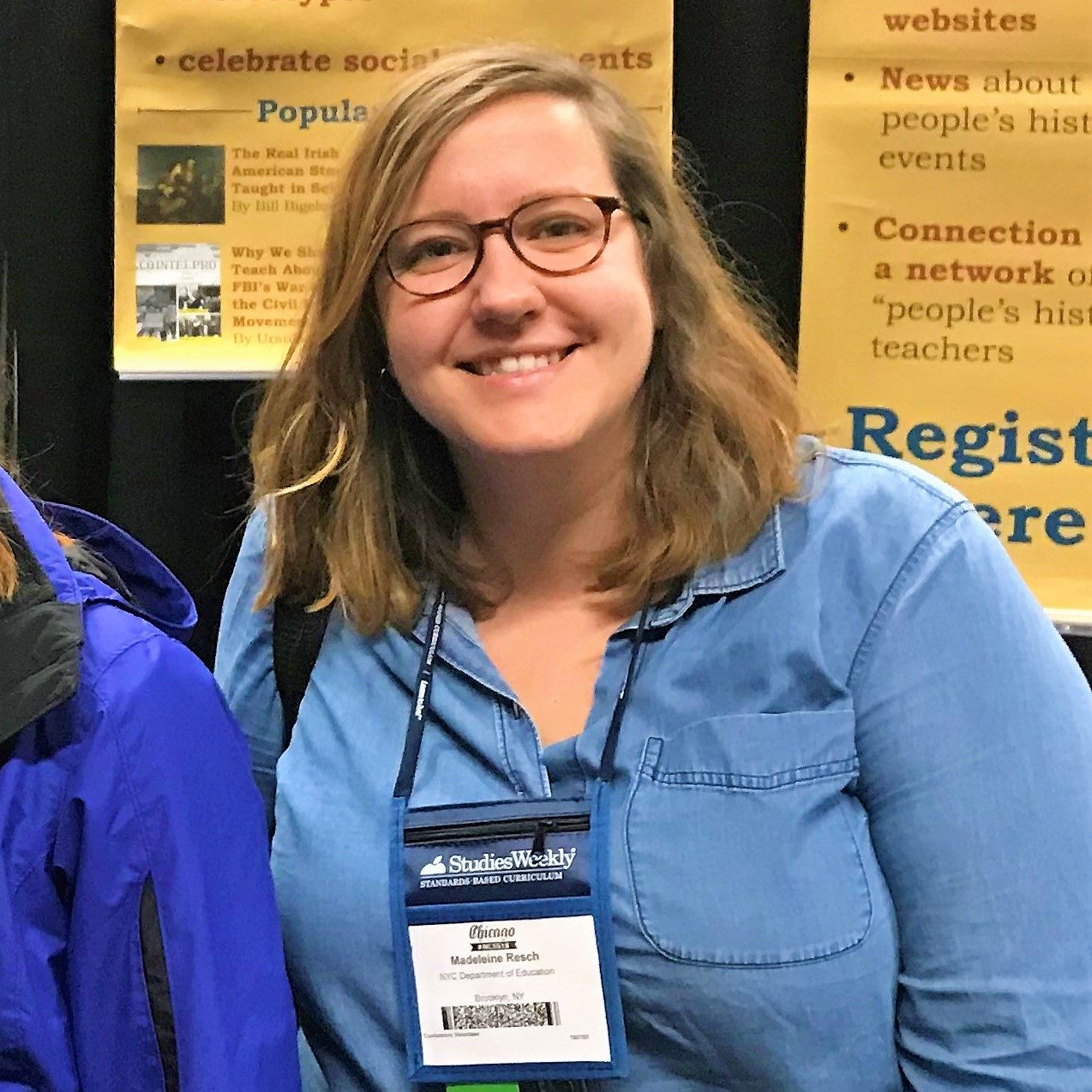
I’ve used a few of the role play activities from the Zinn Education Project over the past few years. I keep going back to them because they work!
The Constitution Role Play and The People vs. Columbus are transformative lessons in cultivating radical empathy and critical analysis in my students around early U.S. history. They inspire deep engagement and content retention.
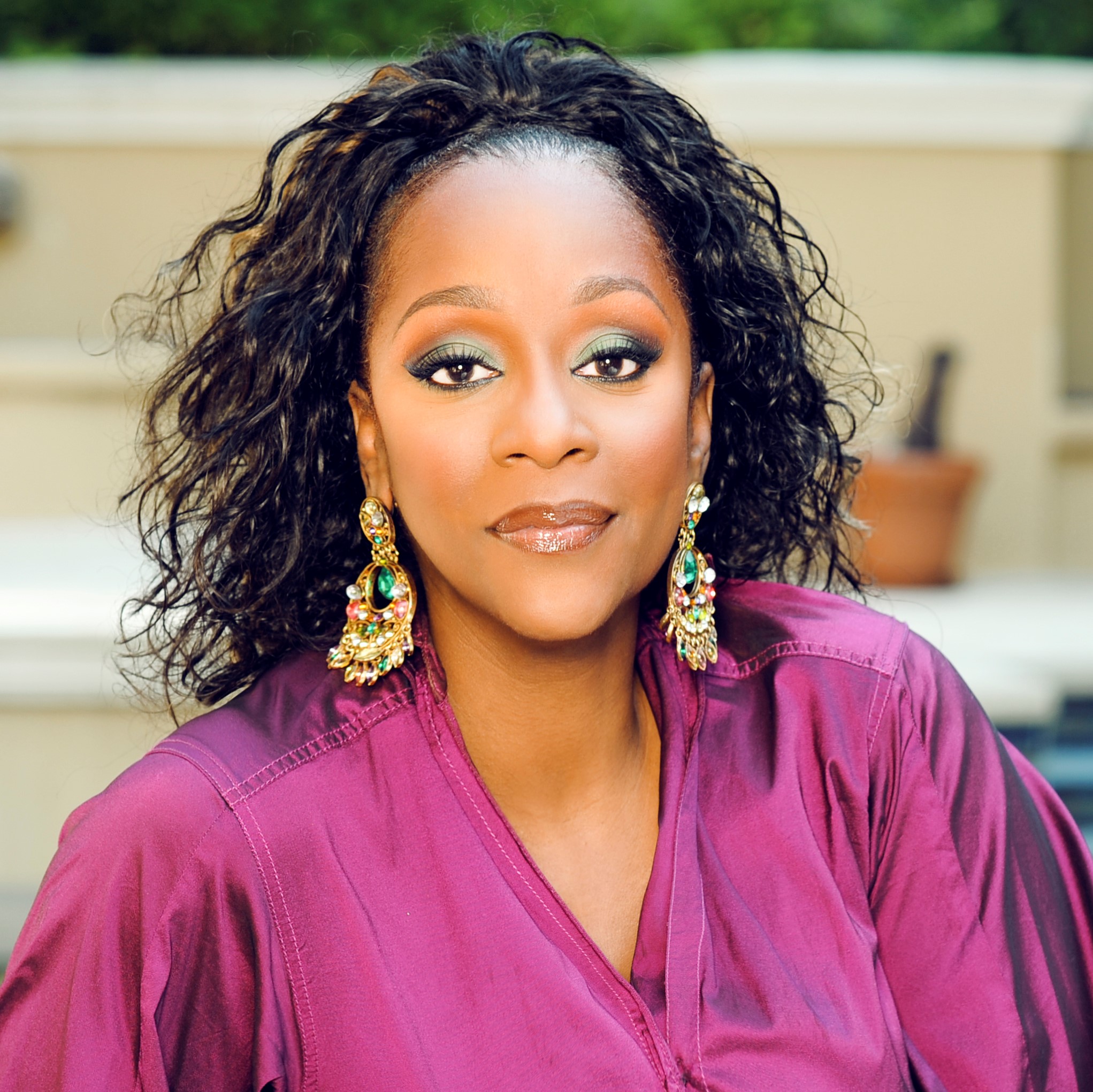
Thank you so much for the Zinn Education Project website. I discovered it while writing a paper for my Africana Studies college class and I’ve spent hours just being amazed at what I thought I knew about history.
Thanks for caring to illuminate minds!
History is one of the ways that enabled and empowered me to find myself early in junior high school. I had a history teacher who made one of the greatest impressions on me ever by throwing our history books in the garbage. Then she told us that she was going to teach us about us! She changed my life.
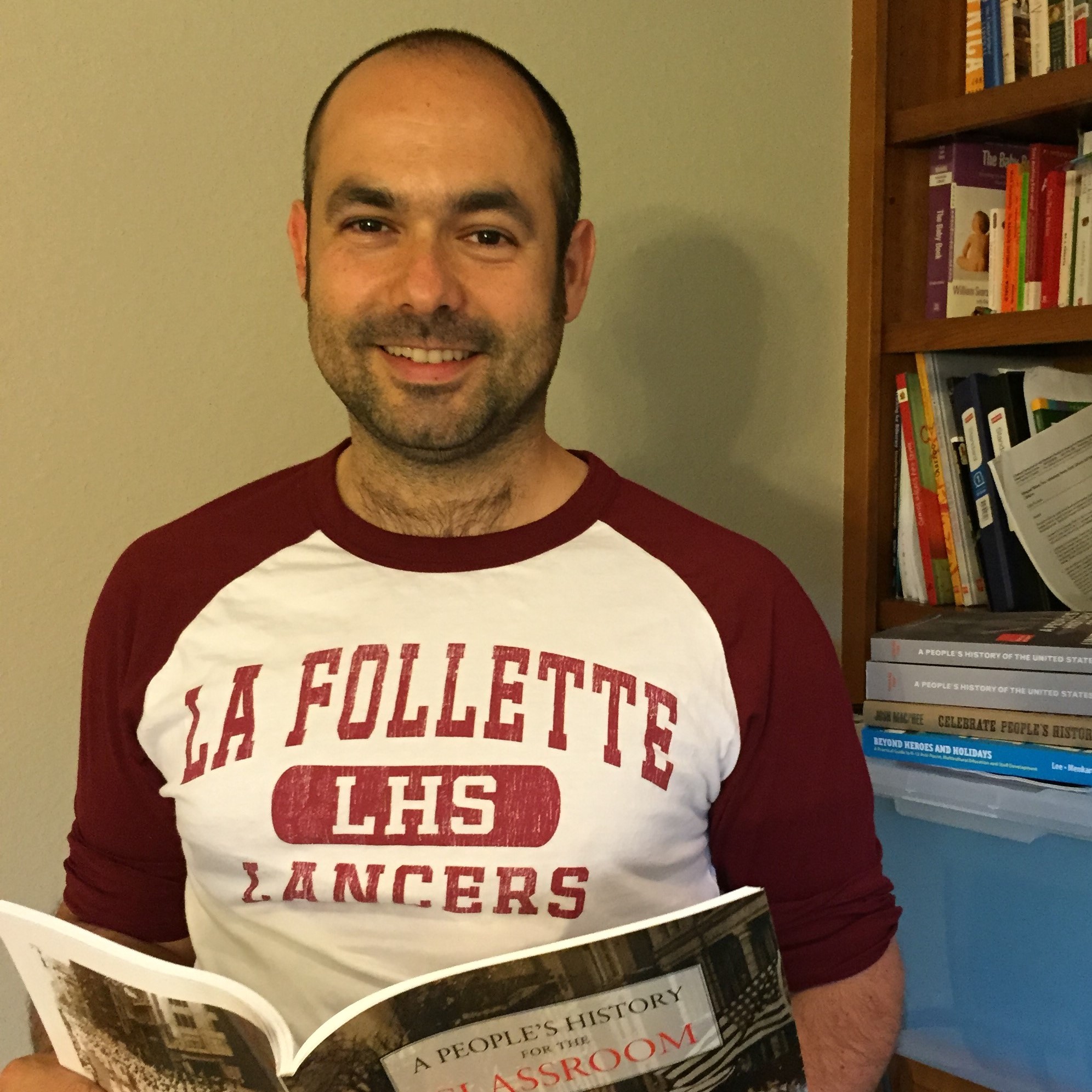
I signed up for the Zinn Education Project because I want my students to hear the voices and perspectives missing from traditional historical narratives and textbooks, and to develop a critical understanding and engagement that empowers them to change their world. The Zinn Education Project offers great, thought-provoking teaching tools to explore a fuller, richer history, and make history classes more engaging, more relevant.

I needed an engaging way to teach history with manageable reading for my middle school special education students. The role plays I found on the Zinn Education Project website were perfect. We started off with The People vs. Columbus and at the end of the year students were still talking about it. The short role play descriptions and chance to debate the issue from many perspectives gave my students an accessible way to understand a complex and nuanced history and critique the standard story.
After searching online, and quite honestly, with not a lot of historical background, I came across your Zinn Education Project website and was COMPLETELY amazed by all of the neat information!! The lesson plans were specific and to the point, for any teacher to easily understand and share with students.
The Zinn Education Project gives students another lens with which to look at history. Students love alternate view points.
American history is not about how the elite did it all for Americans, but how the elite used the lower classes to build what we have!
The Zinn Education Project lessons provide an alternative perspective that broadens the students’ thinking about a topic. They also provide a way for the students to engage with the material in a tangible way.
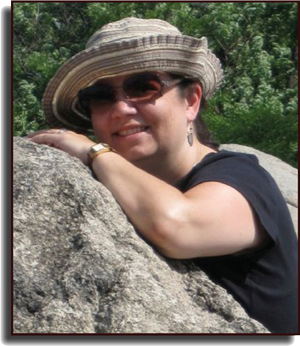
I have been teaching history in Boston for 16 years, and I strive to teach my students that they have a voice and the power to take action. No text helps me do that more than Zinn’s A People’s History of the United States and the supplementary materials provided through the Zinn Education Project. I find your materials to be well-crafted. For example, the role play activity where students take on the identity of people impacted by the U.S. – Mexico War generates excellent discussion each time I use it.
I use thought-provoking statements from Zinn’s text in mini-debate activities, such as a spectrum line. For example, I will ask students to stand along a line ranging from “Strongly Agree” to “Strongly Disagree” in reaction to one of Zinn’s statements. By simply standing, they express an opinion. Student volunteers will then share why they have taken that particular position.
One of my favorite moments using A People’s History came this year when we read about the beginning of differentiation between indentured servants and slaves after Bacon’s Rebellion. A student said, “If racism was purposefully created, it means that people can un-create it.” I couldn’t hope for a better realization, and it is for moments like these that I am excited to continue to use materials from the Zinn Education Project in my classroom.
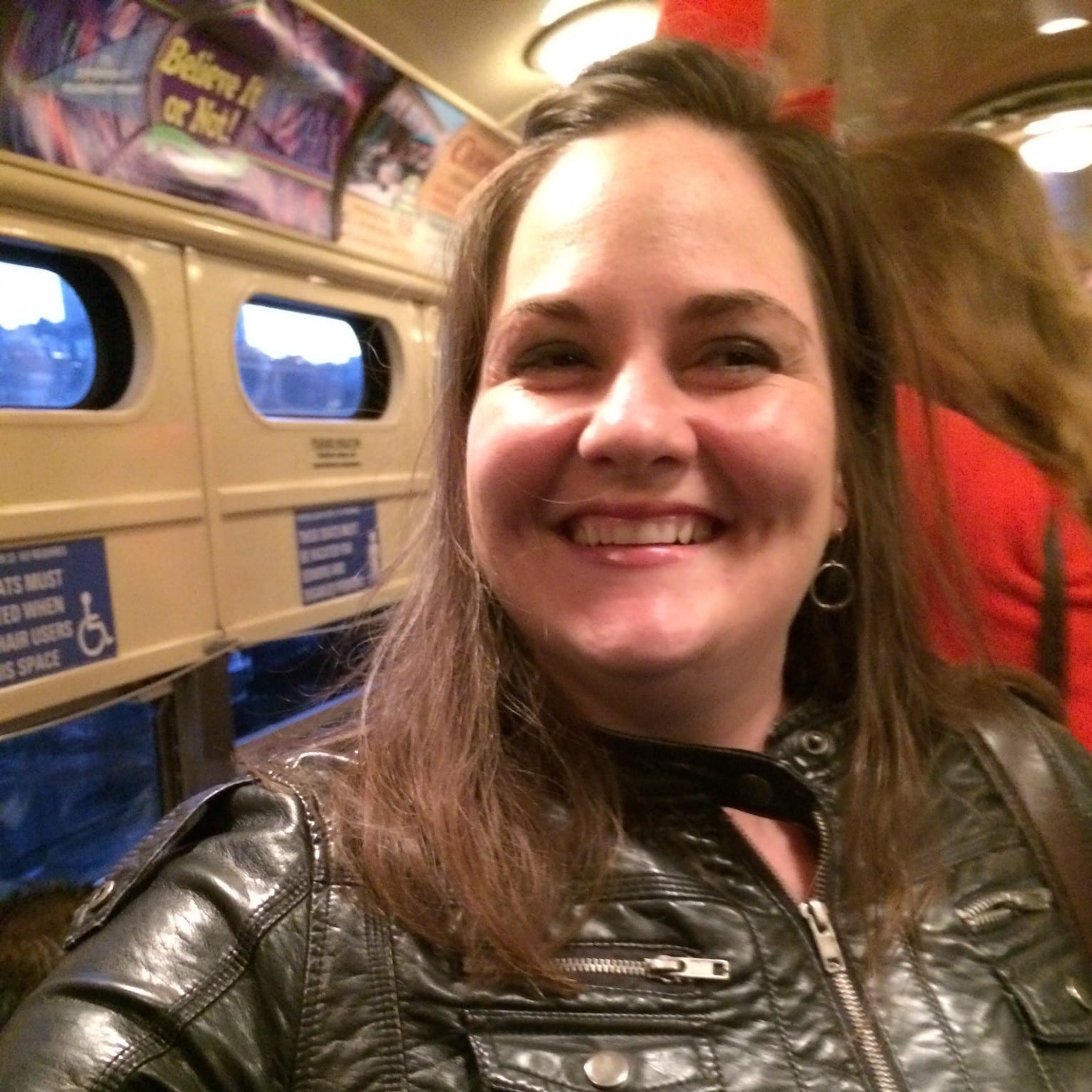
The Zinn Education Project lessons help me conceptualize teaching the whole story.
I know what material I both want and need to cover and, sometimes, how I want to expose students to it, but in the midst of daily teaching, it feels overwhelming to have to come up with brand new ideas by myself . . . why reinvent the wheel?
As their teacher, it has been amazing to watch students grow their critical thinking skills and get excited about history. They’ve explained to me that most history courses in their past have simply been a recitation of events and this is the first time history has come alive for them. It’s an honor and a privilege to be a part of making that happen for them with the help of the Zinn Education Project.
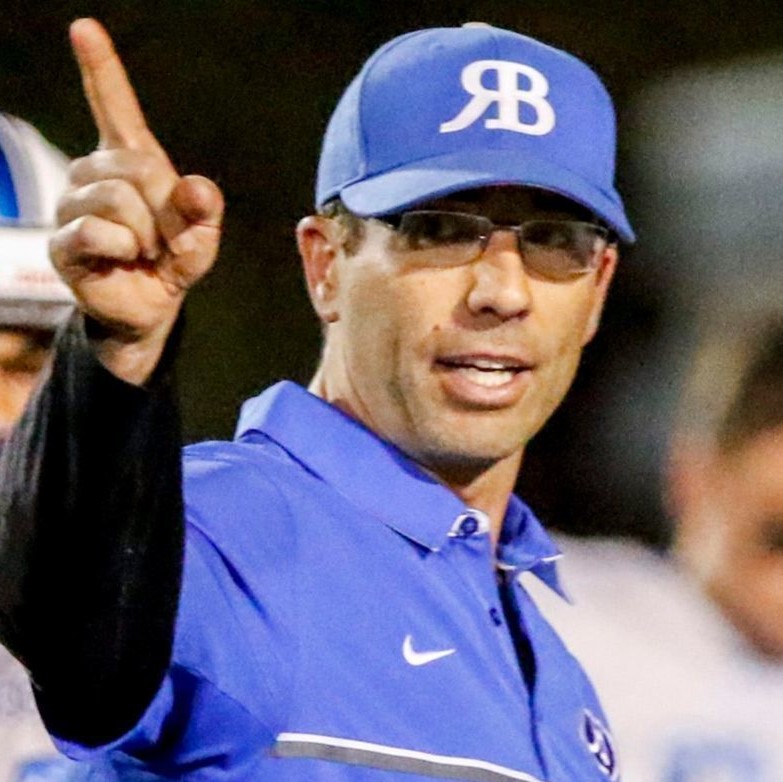
I read A People’s History of the United States when I was in grad school and feel like a fire was ignited in my brain. It totally shifted the way I viewed history (and society in general) and of course has been the foundation of the way I teach history today. I came to the Zinn Education Project website in search of new ways to light a similar fire in my students.
I teach people’s history because it provides my students with buried but important perspectives on the history they assume they already know.
It is vitally important that young people discover that history is not the sole province of rich, famous, white, straight men (like Mitch Daniels, former governor of Indiana).
Instead, we can all contribute to the developments of our country. And, indeed, we all have!
Students question why they were never taught this, which I believe is the whole essence of the Zinn Education Project.
Students are now looking through a different lens to the class struggles and the conflicting motives that radiate within our country.
The Zinn Education Project has not just put together a wealth of great resources.
You’ve also taken the time to differentiate and activate the material. What this leads to is a richer classroom experience for both teacher and student.
I LOVE IT!
I love that these lessons offer an alternative to Eurocentric textbooks.
I love the handouts and how easily I can change the lesson to fit my needs.
I struggle coming up with my own experiential learning lessons, and as a first-year teacher this website really helps me in multiple ways. I get to cater to different students’ learning needs and it makes history interactive!
Civil Rights Movement
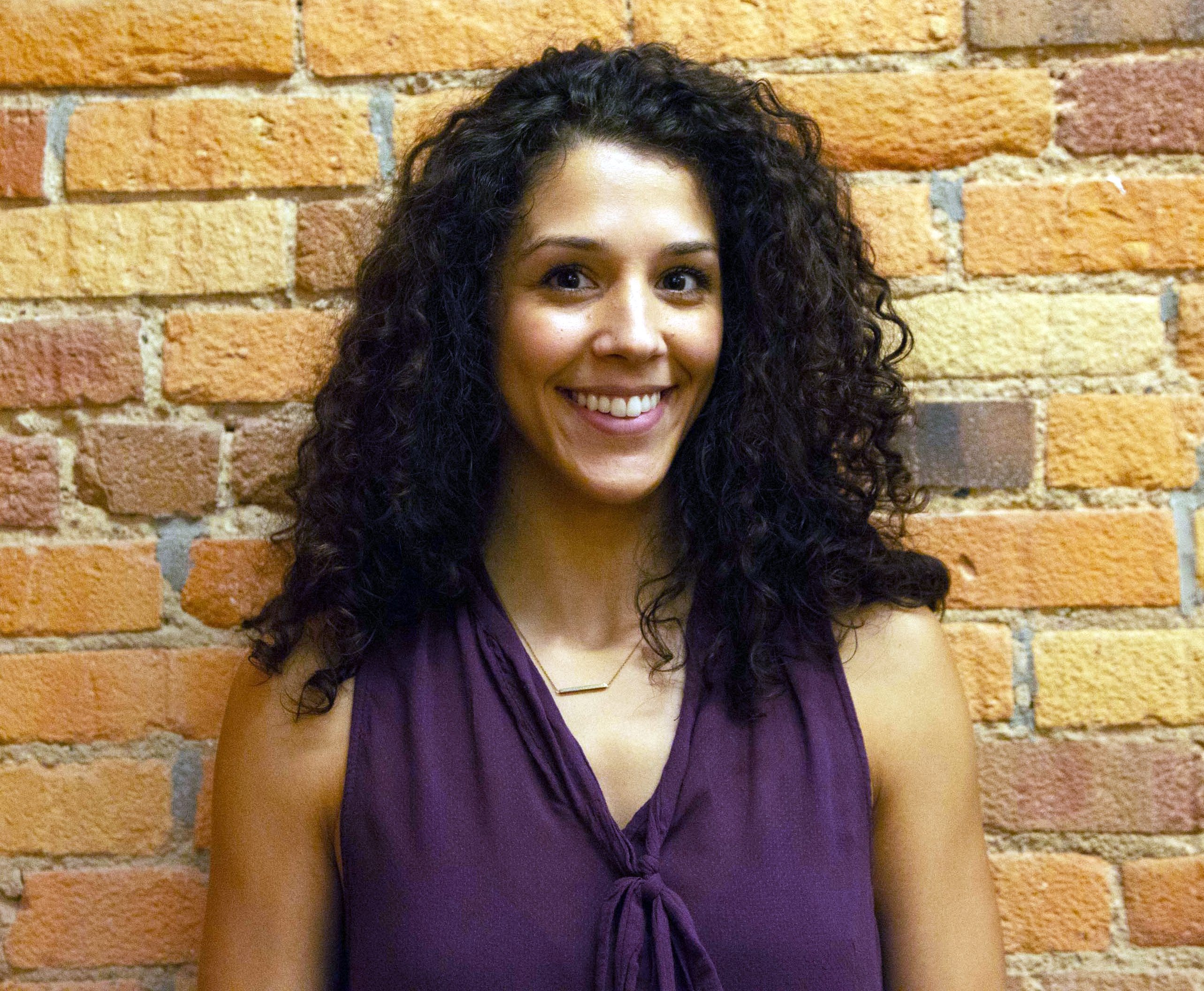
We did the Teaching SNCC lesson, where students have a SNCC (Student Nonviolent Coordinating Committee) meeting to discuss plans and make decisions based on real historical events. I wish people could see how the kids were really strategizing and getting into their roles as SNCC members.
It was so encouraging to me as a teacher to see my students understand the grassroots organizing of the Civil Rights Movement. However, it was even more rewarding to watch them engage with the material in a social, emotional, and critical way. They are not only learning history, they are learning skills that can be applied to real-life scenarios.

My students and I were especially intrigued by the COINTELPRO lesson, which is about the FBI targeting the Black Freedom Movement. In my own education, I was not taught this.
Oftentimes, textbooks teach the Civil Rights Movement as a moment when African Americans stood up for their rights and were granted them under the Civil Rights Act of 1964. However, it does not include the African American struggle in the post-civil rights era.
I believe, as educators, it is our ethical duty to expose students to the truth of American history and the Zinn Education Project helps me do just that!
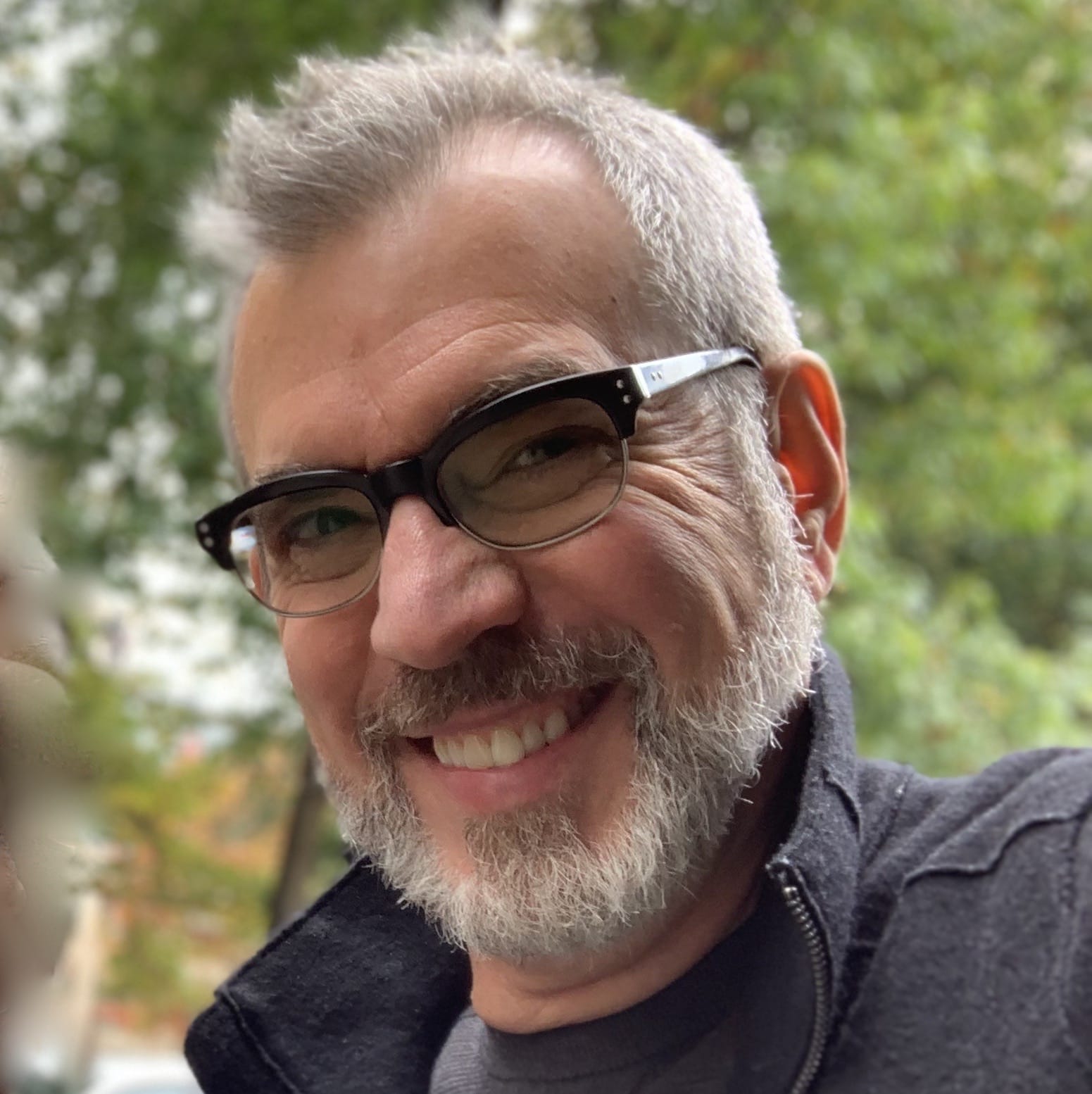
There are so many great elements to the Who Gets to Vote unit. Being a teacher educator, I decided to adapt the first and third lessons for my Master’s in Teaching / Social Studies students. It took about one hour to teach. Teaching virtually over Zoom, here was my procedure:
- Open with them brainstorming on a shared Jamboard “What should be the requirements for voting in the United States?”
- Then, brainstorm some categories of people who have been targeted with voter suppression.
- I broke the class into 3 groups and asked them to brainstorm regulations that would suppress targeted groups of voters.
- The mixer role play was next. I had prepared a condensed list of roles and assigned one to each student.
- Students met in breakout groups to discuss their roles and how any of our new regulations impacted their right to vote.
- Session ended with an open discussion of what they’ve heard on the subject of voter suppression in the 2020 cycle.
My students were deeply engaged throughout the lesson and it generated much discussion. It was interesting for them to consider some of the suppression techniques done by different groups and the extent to which they were based on real-world examples.
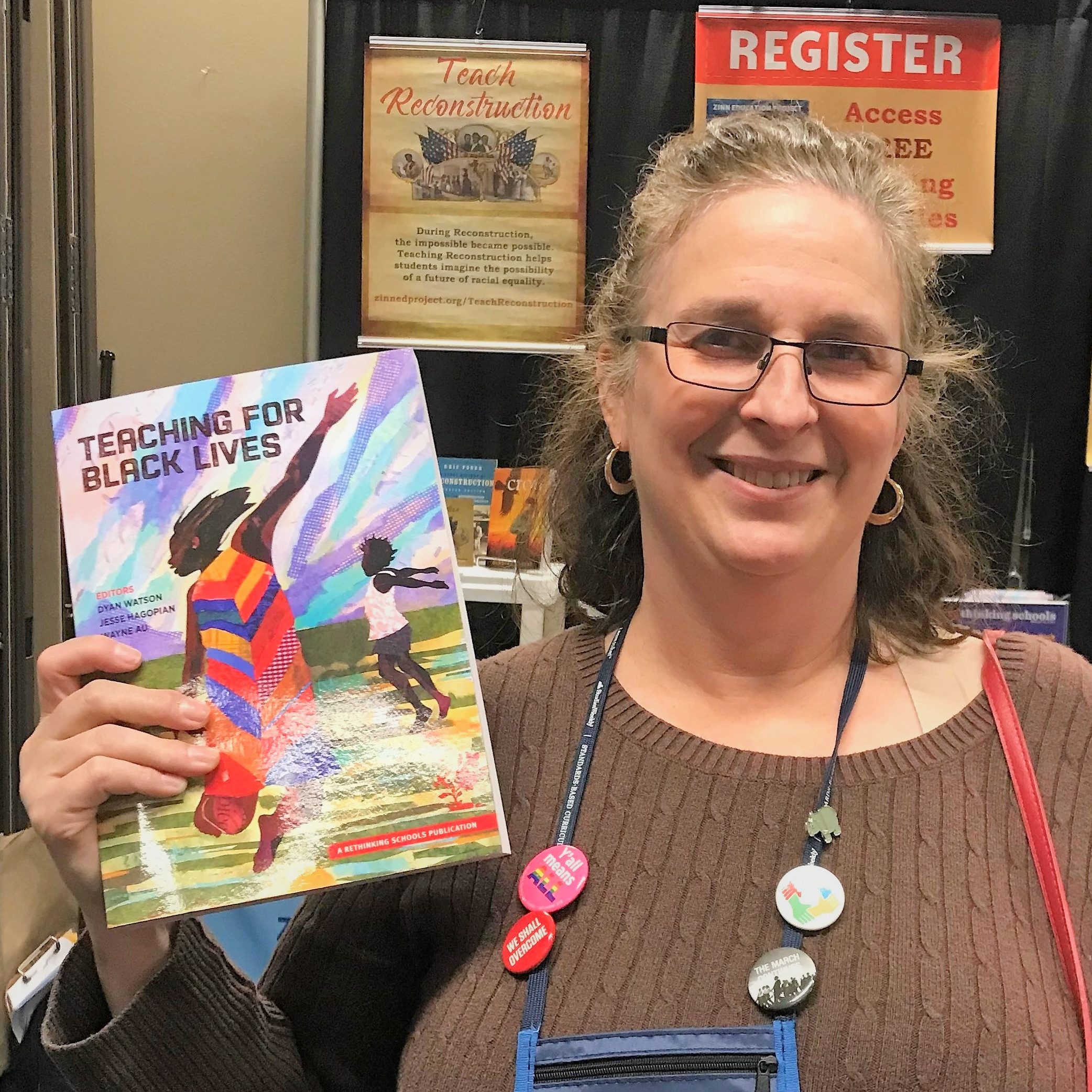
The Teaching for Black Lives book is part of my Civil Rights unit. Using Zinn Education Project and Rethinking Schools activities, students were excited to see themselves in the history. Then, they could make critical connections between the past and the present.
While teaching AP U.S. History I strive to make sure my students understand that so many of the events in “history” were not that long ago, and so much of what has happened in our nation continues to shape what happens today.
By talking about and sharing the stories of activists like Claudette Colvin, Fred Shuttlesworth, and some of the other lesser known (but equally important) leaders of the Civil Rights Movement, I try to make their stories come to life. I also make extensive use of the Zinn Education Project’s Reconstruction curriculum in conjunction with the book How the Word Is Passed to show how the federal government has failed in so many instances to address the problems of racism, discrimination, and public perception from the end of the Civil War to the current day.
More than passing the AP exam and earning college credit, I want my students to leave my classroom better citizens of this country and I think this book, along with many other great resources, helps to accomplish that.
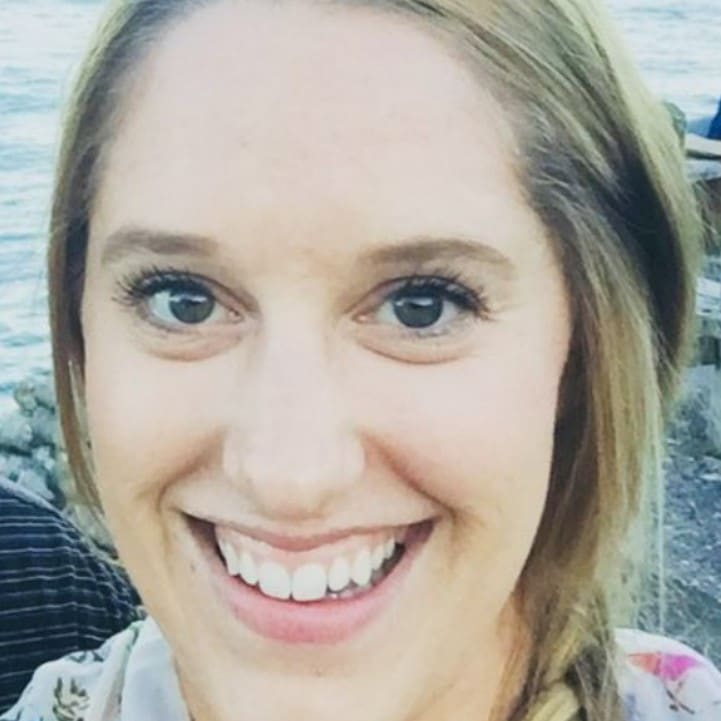
I used Linda Christensen’s Stealing Home lesson and my students LOVED IT! Many connected to this lesson on a personal level. It is a huge piece of getting them to understand the human side to complicated (and boring) government issues.
Housing discrimination and other forms of systemic racism/classism are all themes I touch upon many times throughout the year, but particularly in looking at Civil Rights Supreme Court cases… I work through with students some of the options of the federal government and ask the big question “in what situations should our federal government use its rank over state governments?”
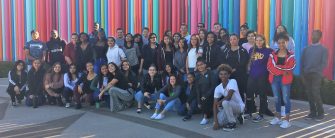
Megan Briere’s class in Las Vegas, NV
Once students better understand these topics through more personal narratives like Christensen’s, it is something they are passionate about post-lesson and they love discussing how these issues still exist today and how we might go about changing them (whether that’s at the federal level or not).
Students gain so much by being able to make personal and lifelong connections to issues involving our government.
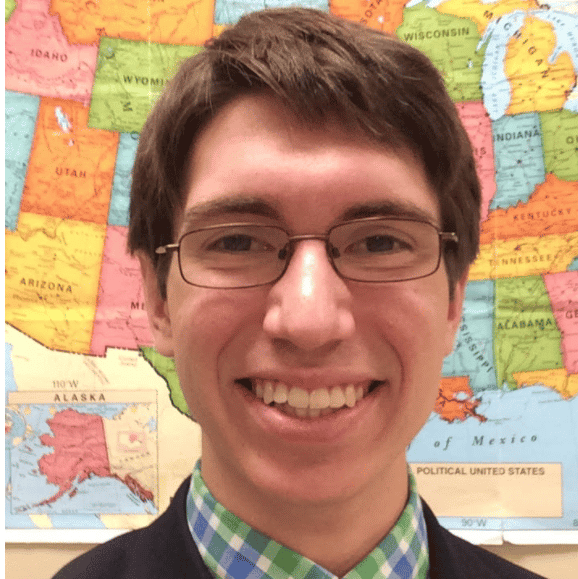
I used the first lesson in the unit, Who Gets to Vote? Teaching the Struggle for Voting Rights in the United States, in my United States government course. It fostered great conversation and insight for my students in considering the importance of voting and factors that hinder voting (especially educated voting). My students hadn’t much considered the importance of voting, and some were despairing about the worth of their vote following my lesson on the Electoral College.
Fannie Lou Hamer’s excerpts, especially the second excerpt, revealed to my students something that they hadn’t previously considered: while they didn’t see value in their vote, they hadn’t considered the challenges that have historically and contemporarily prevented citizens from the ability to vote in the first place.
This lesson led my students to reconsider the value of their voice in federal and local elections. I taught it on election day and I believe that it inspired many of them to vote in the election, some of whom left for the polls straight from school! Thank you, as always, for your great resources!
(See our Civil Rights themed materials.)
Teaching Climate Justice
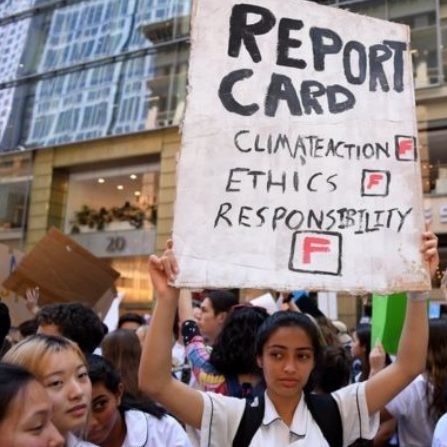
I use the lesson, Meet Today’s Climate Justice Activists: A mixer on the people saving the world as part of my unit on climate change. In my unit, we asked “what is justice” and what it means in regard to climate change. One of the goals of our school is for our students to “take action,” so this lesson gives them role models on how to take action in regard to climate change.
I used it with three of my classes, 125 students total. The students responded well to playing roles including Eve Miller, Harry Smiskin, Victoria Barrett, AOC, Kathy Jetnil-Kijner, Mishka Banuri, Linda Garcia, Hannah Jones, Simmone Ahiaku, Henry Red Cloud, Joanna Sustento, Lucie Atkin-Bolton, Greta Thunberg, Arturo Massol-Deya, Xiuhtezcatl Martinez.
The directions in the lesson were helpful in making the time productive, and I liked the concept of a mixer as the setting for the lesson. At my school, we use a variety of strategies from “The Strategic Teacher” and SRI, but I have never used a mixer before. It was a nice variation that added novelty to the lesson structure, and the students responded well to it.
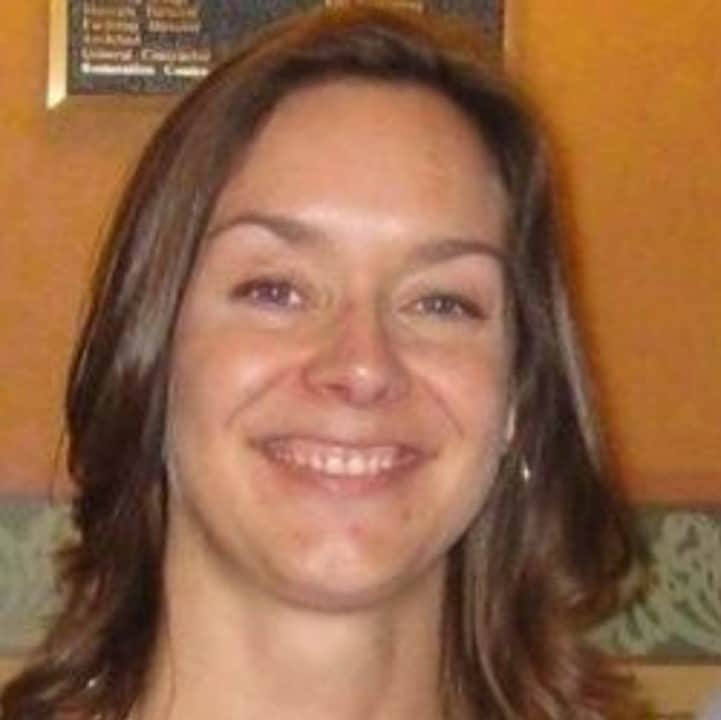
As a teacher educator, I use the Climate Change mixer and the Young People’s Conference on Climate Change in order to support my students’ understanding of how colonialism, globalization, and climate change intersect today. The activities help my students, who are pre-service teachers, to connect science to social studies in meaningful ways and to teach in interdisciplinary and critical ways.
We often build on the two lessons by developing a TourBuilder narrative to emphasize narrative and geography, and have also included PBS’s interactive “The Last Generation.” This site provides a face to people like those under discussion in the Climate Change Mixer and also steps us into discussions of climate change displacement and immigration as well as other economic/political consequences that may seem unrelated.
Having access to these resources has been beneficial in a lot of ways and has greatly enhanced our teaching and learning in relation to climate change.
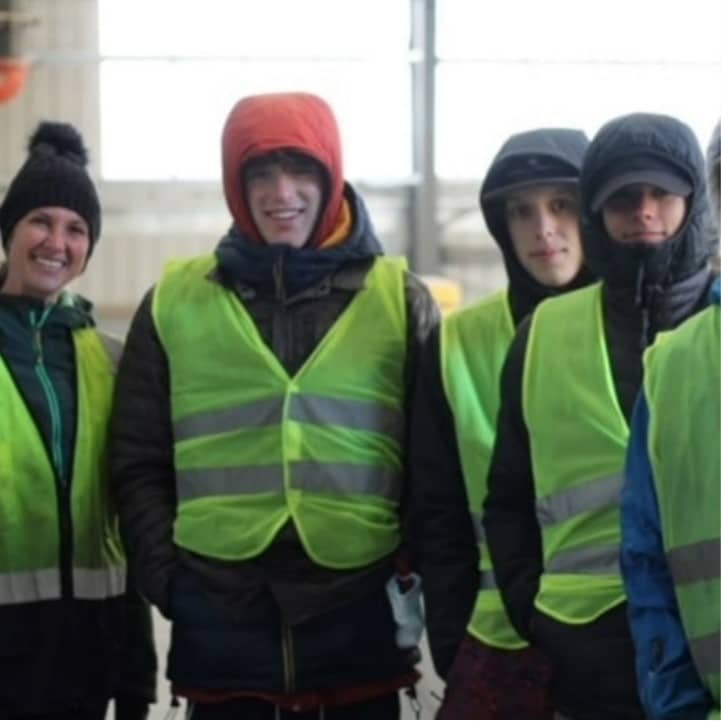
Our school is located in an overwhelmingly white, affluent rural town bordering a national park. It would be an understatement to say our community is isolated from much of the environmental and racial issues plaguing our country today. Not only does The Red Dot of Environmental Racism lesson by Alma Anderson McDonald plainly define environmental injustice for my students, but it also opens their eyes to the fact that these issues are not only playing out in far-flung, developing countries, but also in their own backyard.
In addition, I think the lesson really drives home the idea that environmental injustice is not a thing of the past, but rather something that must be addressed today. It is one more way that our nation has institutionalized racism.
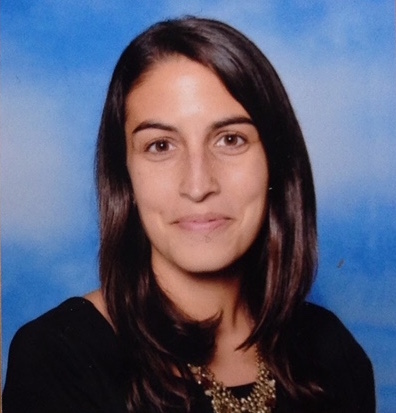
During the Mystery of the Three Scary Numbers: A Climate Change Teaching Activity, my students were uncomfortable, but determined to figure out what these three numbers of climate change meant.
As they worked collaboratively, I watched lightbulbs turn on in their minds when they put all the evidence together. When I asked my class for their thoughts, one student simply said, “I’m angry.”
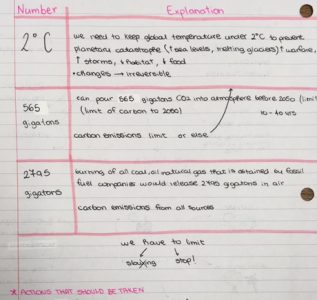
Notes by Giulia Grandi, a student in Kassam-Clay’s class.
The class discussion quickly became a brainstorm for what actions they can take to make a change. They are realistic, taking personal responsibility, in the face of these stark numbers.
Thank you, to the Zinn Education Project, for putting climate change into perspective in my classroom.
I used the Zinn Education Project’s Climate Change Mixer in a problem-solving project with my 8th grade science students, where I had students work in teams to create an essential question around one of the UN Sustainable Development Goals. Then, they had to propose a solution to address their question. They needed to be able to identify various stakeholders and whose interest was being served by their solution.
Once students had their questions, my school’s librarian and I collaborated to have the students engage in the Climate Change Mixer. The different experiences and perspectives of the individuals represented in the mixer activity really resonated with the students. They were highly engaged during the activity, and were able to identify new insights that they gained from their conversations while in the roles.
When they returned to the sustainability questions, the mixer activity helped students identify who is, and who is not, being considered and impacted in their projects’ solutions.
Who’s to blame for causing the climate crisis? Ss explore this ? in an experiential role playing activity from @ZinnEdProject called “The Climate Crisis Trial.” Five “defendants” are on trial for the role each played in causing climate change. High-level engagement and thinking! pic.twitter.com/Wuy1bVG5v3
— Brett Benson (@MrBensonNMS) May 3, 2022
Read more classroom stories by educators in the Climate Justice materials, including Meet Today’s Climate Justice Activists, ‘Don’t Take Our Voices Away’: A Role Play on the Indigenous Peoples’ Global Summit on Climate Change, and the Climate Change Mixer, or view our collection of Climate Justice testimonials.
Share your Teach Climate Justice classroom story with the Zinn Education Project to receive a free book.
Abolition Movement and Resistance to Slavery
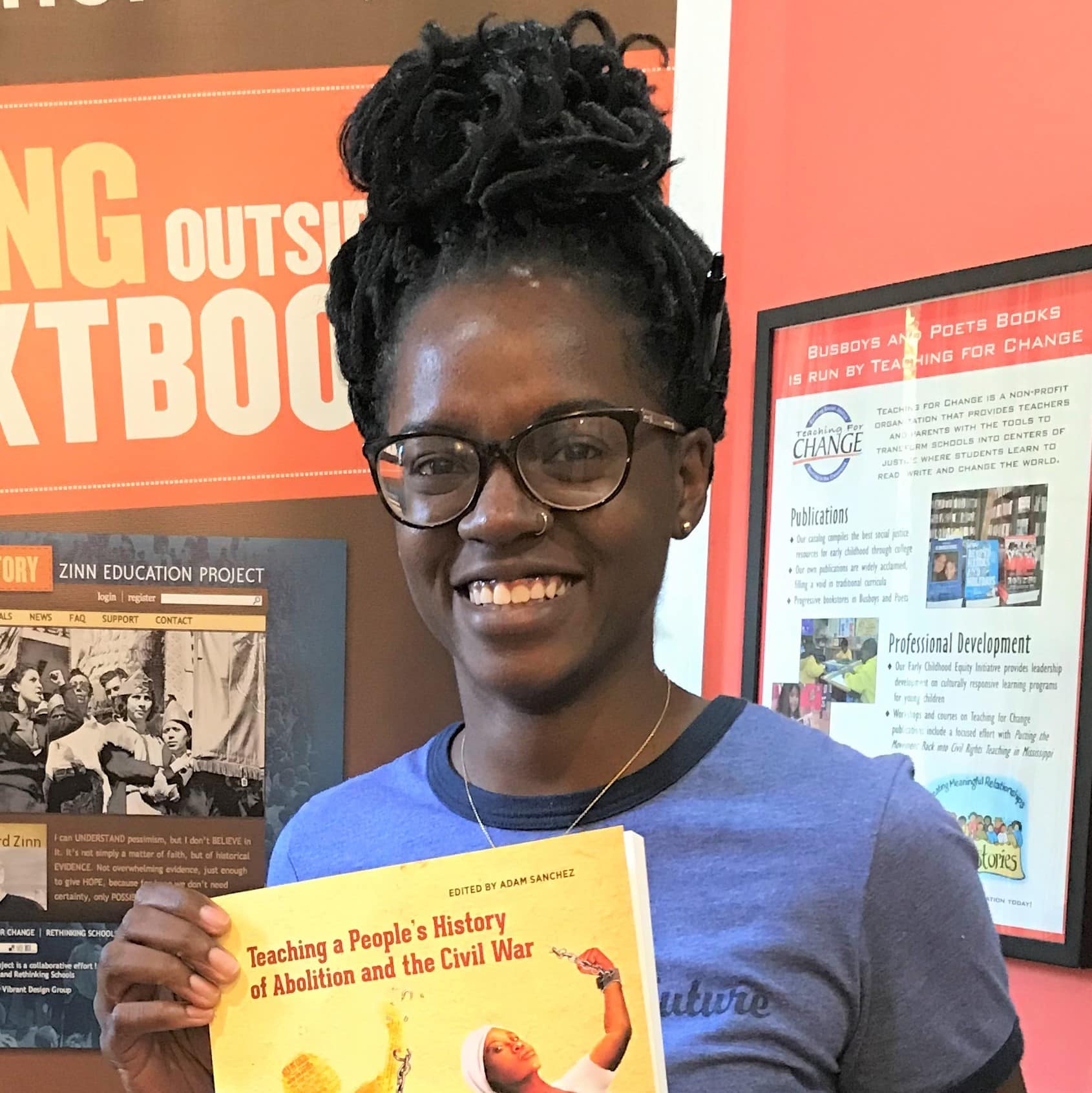
Last year, I wanted my students to have a deeper understanding of the legacy of resistance before, during, and after the Civil War. So, I decided to teach the Poetry of Defiance lesson. I wanted to dismantle the idea that African Americans were bystanders in the fight against oppression.
The lesson was so well-received and sparked such great dialogue amongst my students that now I am attempting to use at least one Zinn Education Project lesson during every unit. . . . Continue reading
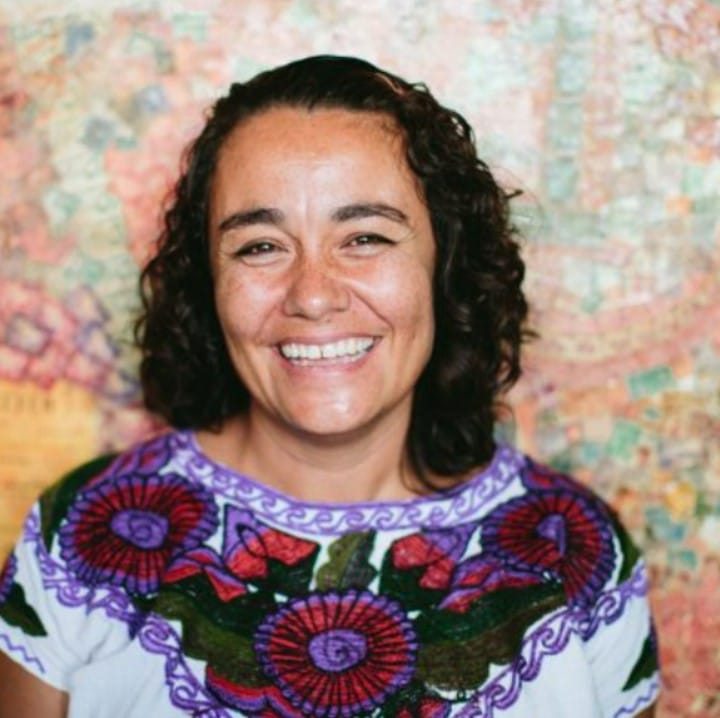
I used the Black Abolitionist biographies in a lesson where my students explored and learned about resistance to the institution of slavery before the Civil War.
First, we established norms around vocabulary, words that we would use to speak about slavery to shift the language away from dehumanization. Then, we listened to historical narratives from the Museum of the African Diaspora archive from the museum in San Francisco. We looked at the abolitionists’ biographies on the Zinn Education Project website and had a “tea party” where students discussed the person they read about. Finally, we watched the PBS special on William Still and ended the unit with a field trip to see the film Harriet.
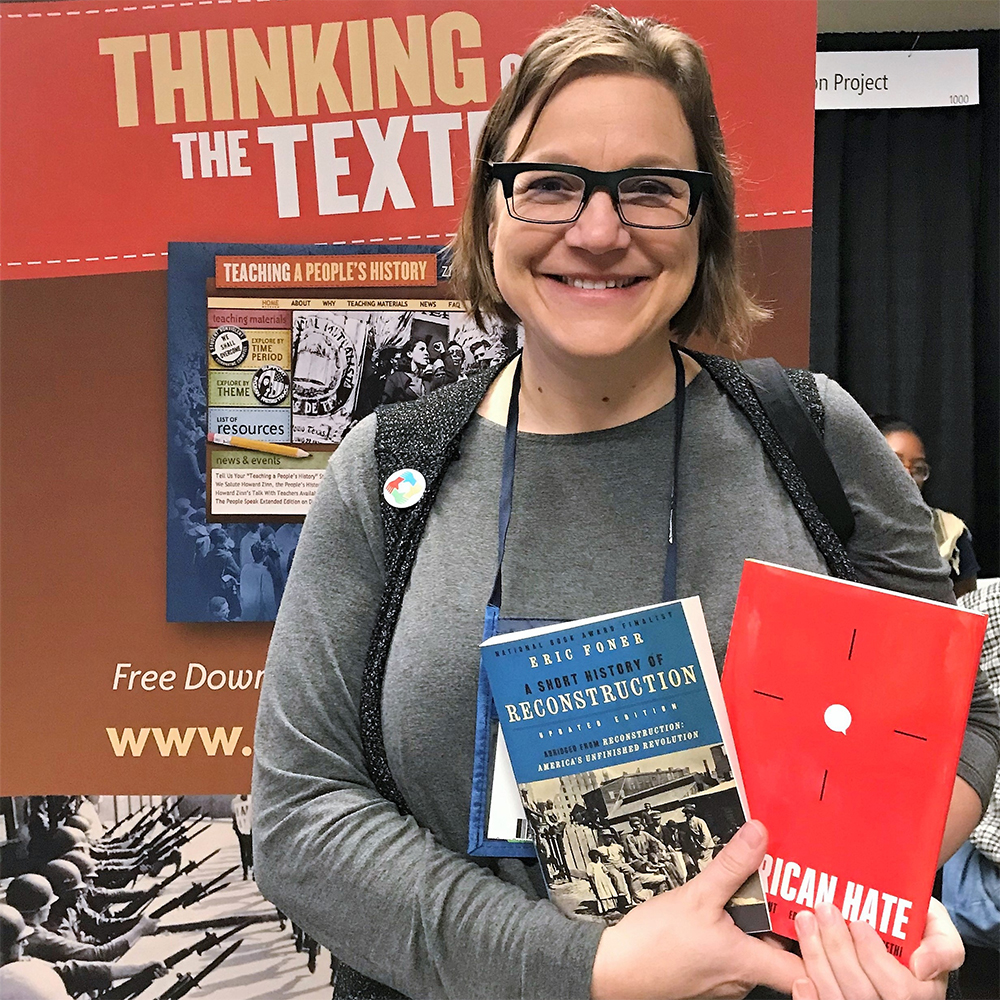
Adapting Adam Sanchez’s lesson, Poetry of Defiance: How the Enslaved Resisted, for online learning was a labor of love. The Rethinking Schools/Zinn Education Project’s mixer activities have been a catalyst for understanding in my classroom; I couldn’t imagine any space — even at a distance — that didn’t include that power.
The first hurdle to overcome was the difference in participation between a captive audience in class and students logging in when they can at home. There are the logistics of asynchronous participation which come from any online learning scenario. And there is particular care to be taken specifically during the COVID-19 outbreak, when families are experiencing stress and upheaval at home. . . . Continue reading
This is my first year using Zinn Education Project after learning about it in my grad program in Chicanx Studies at California State University, Northridge. I was nervous about moving from 20 years in 5th grade, teaching multiple subjects, to my first year teaching 8th grade ELA & History. The Zinn Education Project was exactly what I was looking for, which is to be able to make history come alive in the classroom and to tell the stories of all voices in history.
Our class wrote “Write That I” poems that brought us all to tears after learning about the resistance of the enslaved. We’ve re-enacted the Constitutional Convention, joined and held meetings as members of the American Anti-Slavery Society, and are currently preparing to plea to President Jackson about moving the Cherokee and Black Seminoles west to Oklahoma. Our students are engaged, angered, driven, and eager to learn and I can’t thank this project and all the hard work that’s gone into writing these lessons enough. I also can’t help but thank all of the voices of the people throughout history that have been ignored, overlooked, displaced, or killed in an effort to keep history one-sided.
COINTELPRO
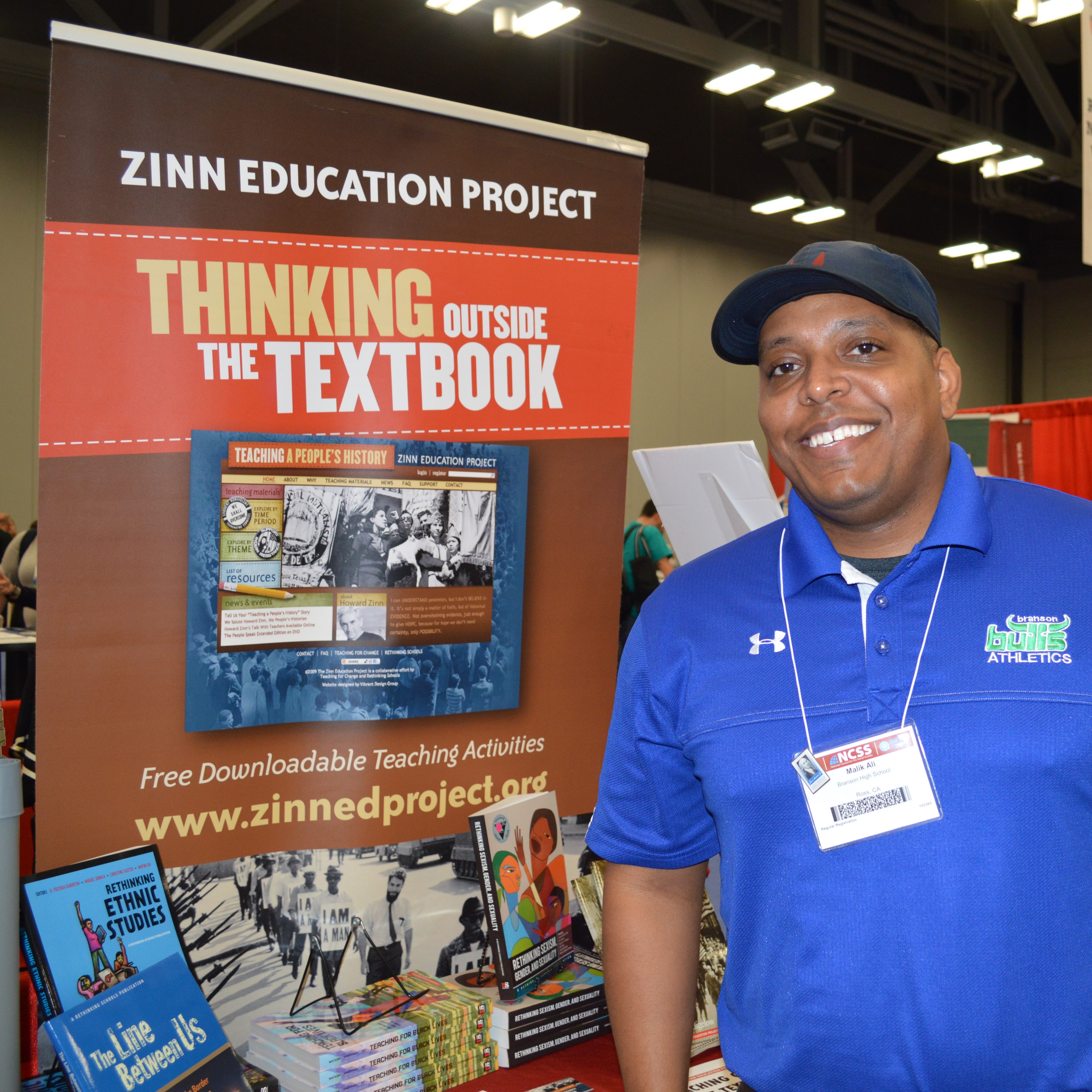
The Zinn Education Project’s COINTELPRO lesson plan made for a remarkable class session. I used the lesson as a capstone to a Civil Rights/Black Power unit.
While the underlying background sometimes astounded students, it was being able to see the historical narrative grounded in primary source documentation — to see a story that might seem beyond belief for some of them — that really inspired them to pay closer attention to their work.
They dug into and debated every paragraph of every document! It was an energy boost, new fuel for their thinking and communicating, for the remainder of the semester.
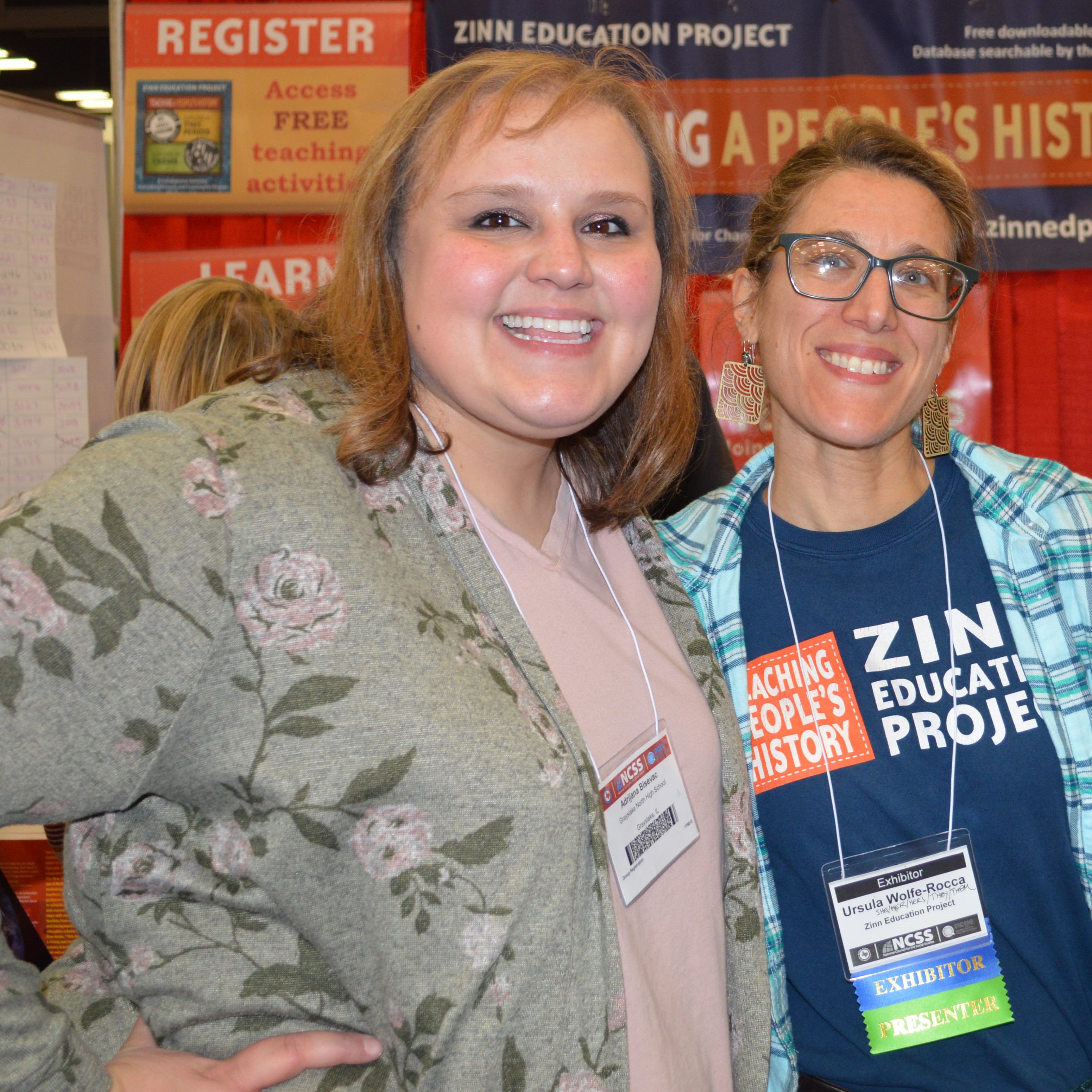
I was incredibly impressed with the materials presented during a workshop on the Civil Rights Movement and a COINTELPRO lesson by the Zinn Education Project during the NCSS conference in 2018. Since then, I have used facets of that specific lesson, such as the sources on the Black Panthers, in class to spark discussions with my students.
I was so happy I discovered both the Zinn Education Project and this lesson, in particular. It provides a different lens that I had not previously given to my class, regarding the Black Panthers. The lesson as a whole allows for links to current events and issues in today’s society as well.
The Zinn Education Project has helped me to expand my understanding of United States History. I was first introduced to them at the NCSS conference in Chicago back in 2018 and I was impressed by the passion that they have for sharing the parts of history that traditionally go untold.
The people’s history lessons have become one of my favorite tools for my classroom. (A personal favorite of mine is their COINTELPRO lesson.) Their lesson writers are able to create engaging activities for the classroom that are also incredibly practical.
Teaching Reconstruction

I recently used the lesson plan When the Impossible Suddenly Became Possible: A Reconstruction Mixer in my 9th grade Honors U.S. History class. I had previously used the ‘If There Is No Struggle…’: Teaching a People’s History of the Abolition Movement lesson, where I had students take on the role of members of the American Anti-Slavery Society to debate abolitionism in the mid-1800s. My students had enjoyed that activity, and when I found the “Reconstruction Mixer,” I was excited to try it.
For context, this lesson came after a few days of discussion and reading about the Reconstruction Era. Students had built some background knowledge about Reconstruction, the major goals/problems, and the backlash to increased civil rights and freedoms of African Americans. We had looked at examples of Thomas Nast’s political cartoons for perspectives on Reconstruction in the North, and students had done a gallery walk of “Black Codes” passed in Mississippi right after the Civil War.
I felt that this lesson would open their eyes to the myriad possibilities that existed for change during Reconstruction and get beyond the typical, textbook narrative that it had failed due to political compromise, or worse, because of poor governance by “carpetbaggers” and African Americans in the South. I taught the lesson in one day, and I found I needed to do minimal setup for students to take on the role of a historical figure. My students loved the chance to get into “character” and think about what their historical figure had stood for. Once the mixer got started, students naturally took on the roles and partnered up to share their stories and gather information to answer the questions included in the plan. We haven’t studied the Women’s Suffrage Movement or the Labor Movement so it was a great chance for students to start to get background on those issues in a very organic, unscripted way.
I had students reflect on 3 questions after the mixer: (1) Whose story did you find most interesting? Why? (2) What did you learn about the Reconstruction period from this activity? (3) How did you feel about this activity? Some student responses:
The Reconstruction period was the best time to fight for equal rights and establish new laws!
I found Henry Highland Garnet’s story to be the most interesting because he continued fighting for other people’s freedom.
I learned Black people got to have some freedom in the Reconstruction period.
I learned that everyone had different reasons to fight for equal rights, women’s rights, or Black men’s rights, and sometimes these people didn’t all agree.
It was cool! I wish we had more time!
Many different people were taking a chance to change America.
The role-plays, simulations, and general outside-the-box teaching activities offered by Zinn Education, including “When the Impossible Suddenly Became Possible,” give me an opportunity to teach history in a way I wished my high school teachers had embraced. The creators of these lessons clearly understand that students often learn best from EACH OTHER rather than through direct instruction, rote memorization, or textbook reading. With minimal background and setup needed, this lesson was a powerful addition to my unit on Reconstruction.
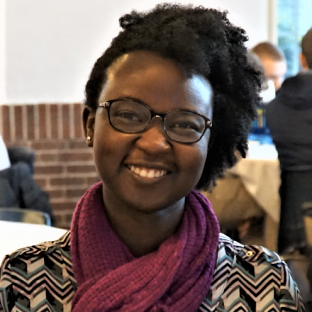
My experience learning about the Reconstruction Era in school (which I’m sure was like most people’s) centered around the Reconstruction Amendments and the actions of the President and Congress.
As a teacher, I wanted to go beyond the amendments to introduce my students to the individuals who were involved in the abolition movement and the fight for equality and justice.
The Reconstruction Mixer lesson did just that. Students took on roles of people involved not just in the abolitionist movement but also in the women’s rights and union workers’ movement. It’s a good day when students know the names and stories of people who fought for justice in their community and their nation.
The diversity of the people included in the activity led to some interesting conversations. In our post-mixer discussion, students spoke up about the tensions between different movements, especially the abolitionist and women’s rights movements.
My class delved into a deeper conversation about what to do when you don’t get what you are fighting for — do you support the other movements or do you stand firm and focus on only what you want? This is a discussion we would not have had if we had just looked at the Reconstruction Amendments and the actions of the people at the top! I will definitely be doing this lesson again in my class.

When I started planning this year’s U.S. History course at Harwood Union High School in Duxbury, Vermont, I started “from the ground up,” meaning with the grassroots and with the stories and experiences of the actual people who lived here before Europeans. All year, I have continued to help students learn to “read” histories as stories, told by various people, but usually by “the winners.” Our guiding question for the year concerns not “history(ies)”, but the past. The actual past as it happens, which takes more work, and it takes breaking with conventional myths and texts.
Reading A People’s History of the United States almost 30 years ago changed my life and helped me break with those myths and texts and how I understood the world. It also influenced me as a journalist in the United States and Haiti.
I wanted to offer my students the same inspiration and ongoing epiphany (or series of epiphanies) and so I’ve been putting in many extra hours revisiting the work of Howard Zinn and others and also discovering new resources.
In the fall, we spent some five weeks studying Native American nations, oppression and resistance, and then proceeded to settler-colonialism and so on. The lessons and activities would not have been possible without this website, Voices of a People’s History, articles by Bill Bigelow, and a few other sources . . .
When the Teach Reconstruction report emerged, I was blown away. Together, the students and I radically altered the syllabus and we spent about three weeks on this period, watching parts of documentaries, reading some Eric Foner, some primary sources, and parts of the report.
Finally, I gave students an assignment that involved lobbying our department about the importance of teaching a specific topic: either Reconstruction, or one of the other crisis-level issues we’d been studying — gerrymandering, Citizens United, voter suppression, and a few other similar issues. Most chose Reconstruction.
Students were invited to either write a letter to everyone in the department with an accompanying draft lesson plan, or create a “persuasive poster” with additional information online via a QR code. Below are some of the posters.
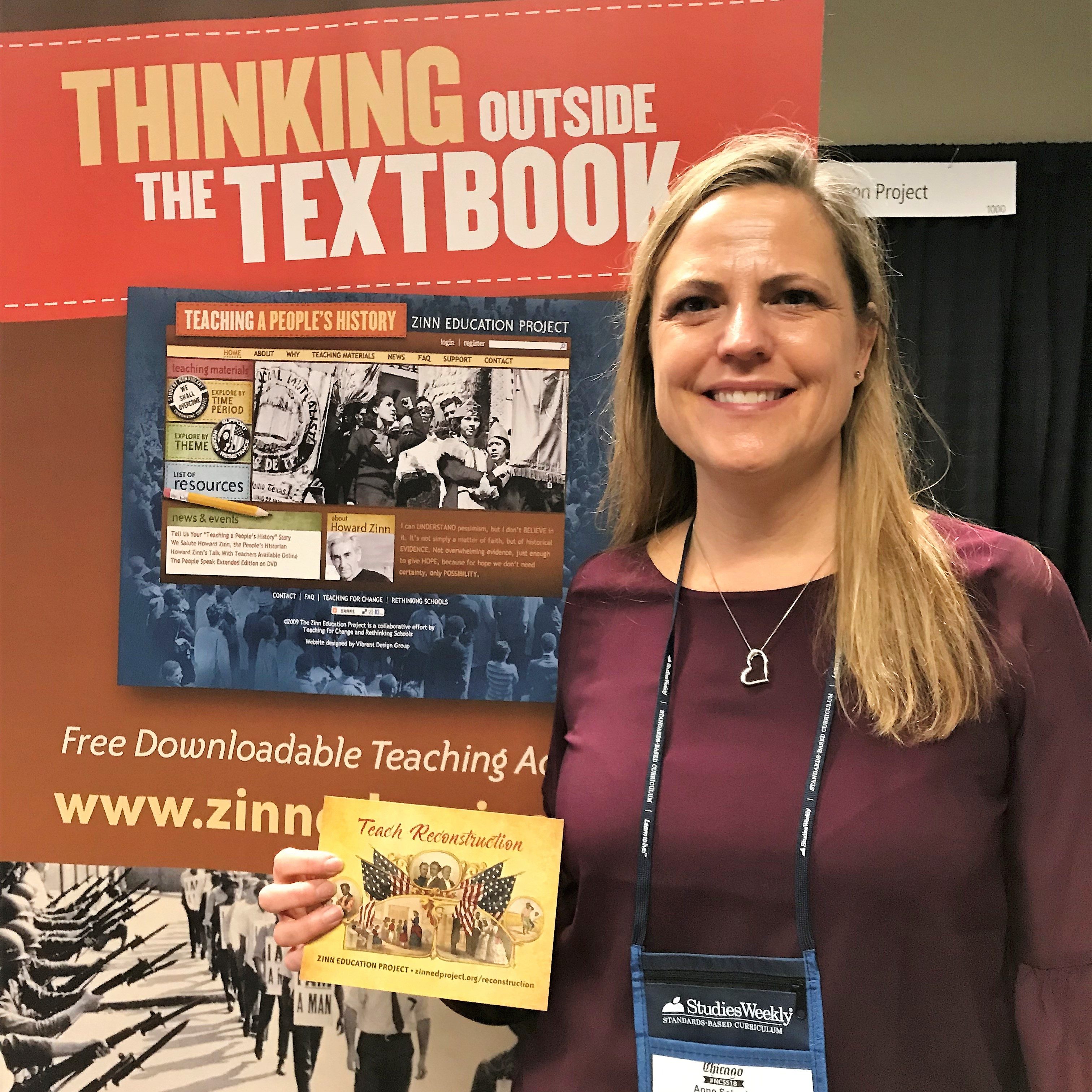
I have been teaching 7th grade history (supposed to be from Jamestown to Reconstruction) for five years. Every year, 7th grade teachers would run out of time and would end with the Civil War. The students would leave thinking, “Hooray! The Union won! Slaves are free! Life is perfect!” They would start 8th grade after Reconstruction — so our students completely missed one of the most important eras of history that still impacts our world today.
I made it my mission to teach Reconstruction.
I found the Zinn Education Project website and the lesson plan Reconstructing the South. From the clear lesson plan, my students were able to empathize and understand the experiences of the freed people during Reconstruction.
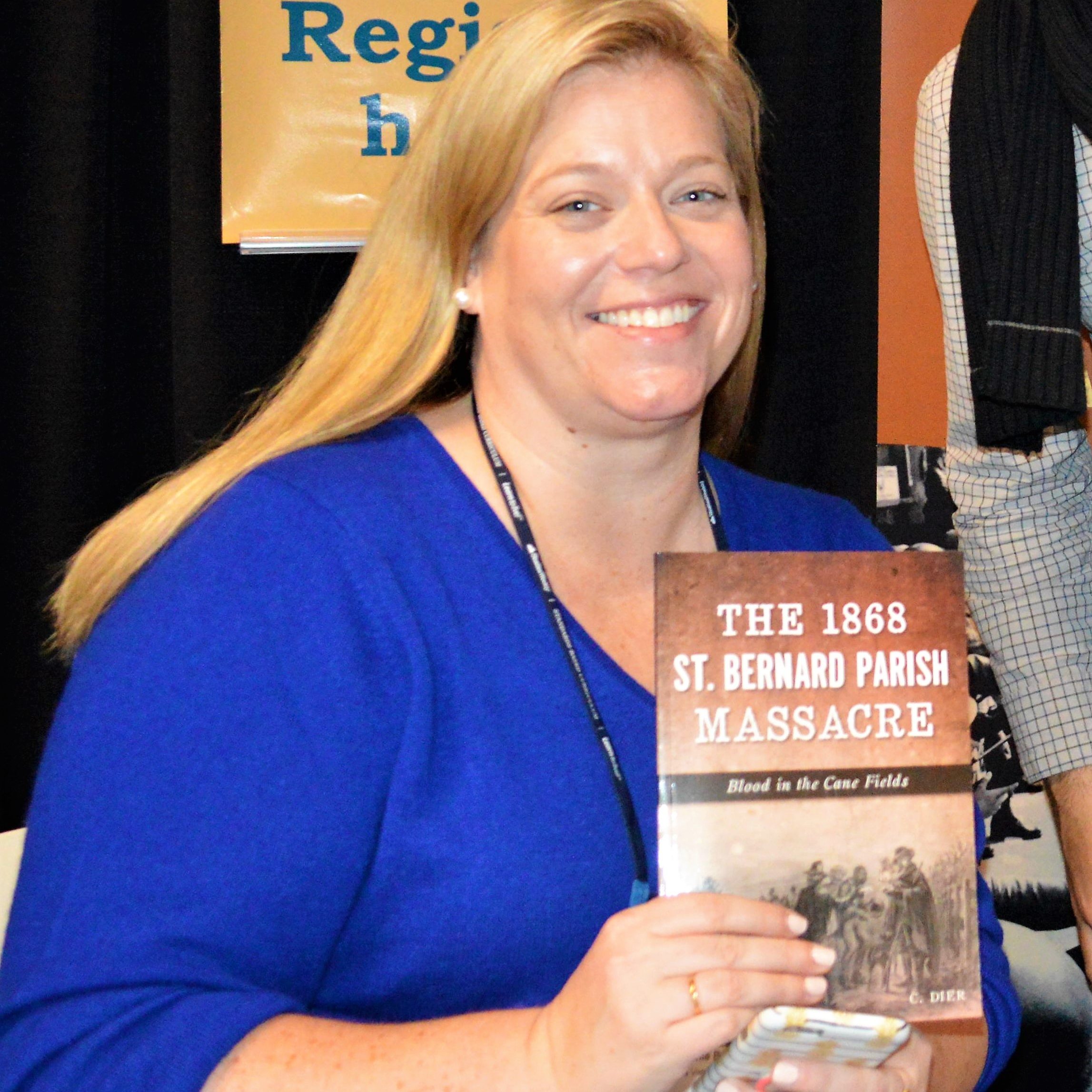
Reconstructing the South is a great lesson for helping students understand the history of Reconstruction and also how myths surrounding Reconstruction influence how many people look at Reconstruction history today.
The Lost Cause Mythology has held a grip of falsehood on American “memory” for much of the 20th and now into the 21st century.
This lesson from the Zinn Education Project help students to understand the role of African Americans in the post-Civil war south and how white southerners actively worked to end these gains.
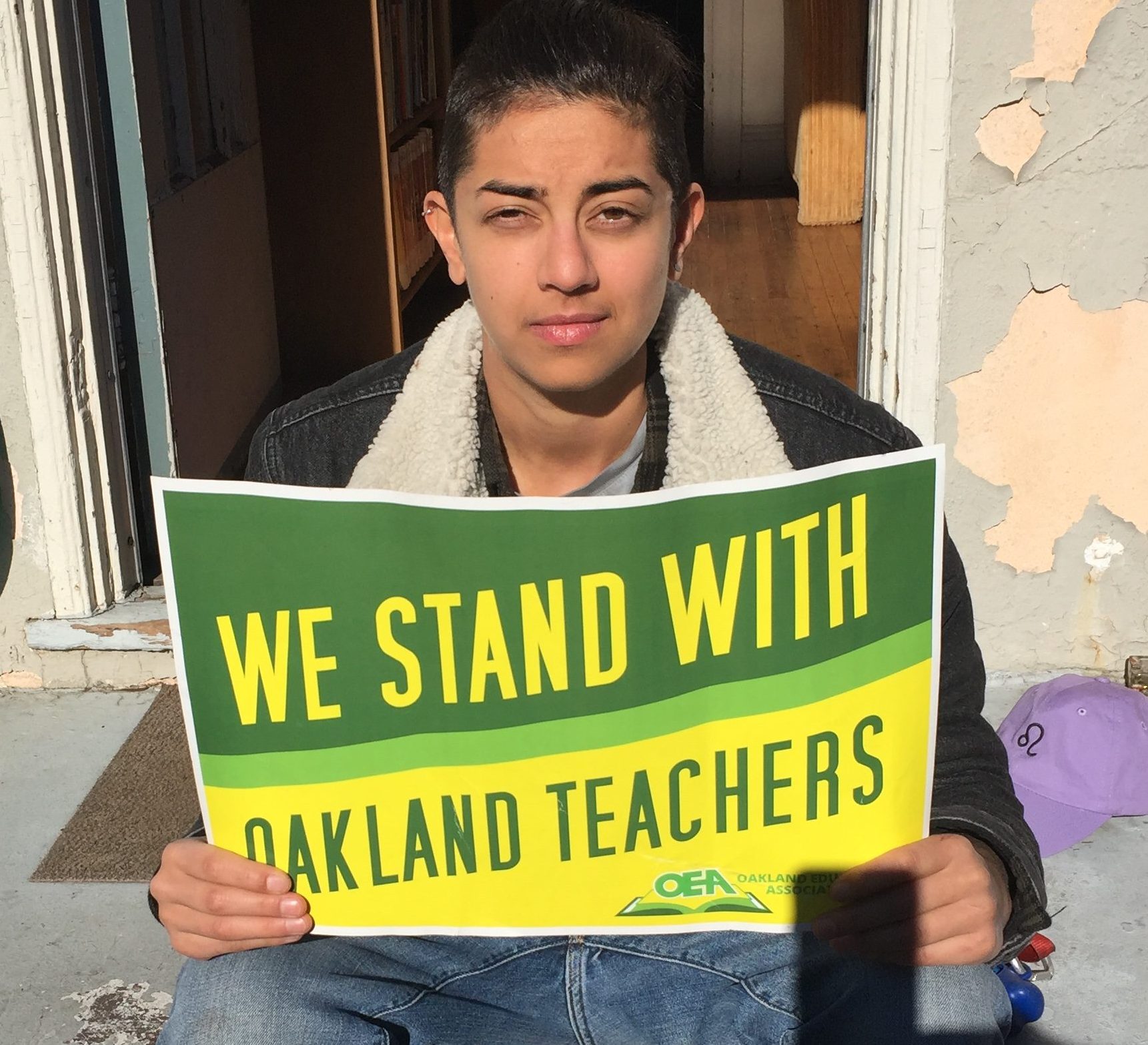
Reconstructing the South is an excellently planned role play — the questions and the sources really got students engaged in the moment of possibility around Reconstruction, rather than looking back on history as “an important lesson” but one that was predestined to turn out specific way. Students of all skill levels were hotly debating these issues, and were eagerly citing evidence to support their positions. One group of students went so far as to calculate a daily wage for freedmen and women to be paid if they agree to farm part of their land with cash crops for the government, and then attempted to convert the amount into its 1875 equivalent!
Students tied the activity into the next part of our unit around change into the Civil Rights Era, and studied the Montgomery Bus Boycott and Claudette Colvin, and now are engaged in the Black Panther Party. The activity really helped me as a teacher (still in my first year!) think about what makes awesome historical thinking questions that center the counter-narratives in American History. Awesome resource and I highly recommend to teachers. The only thing I feel could be improved is some suggested scaffolds for language learners in terms of the source documents.
More teacher voices on Reconstruction
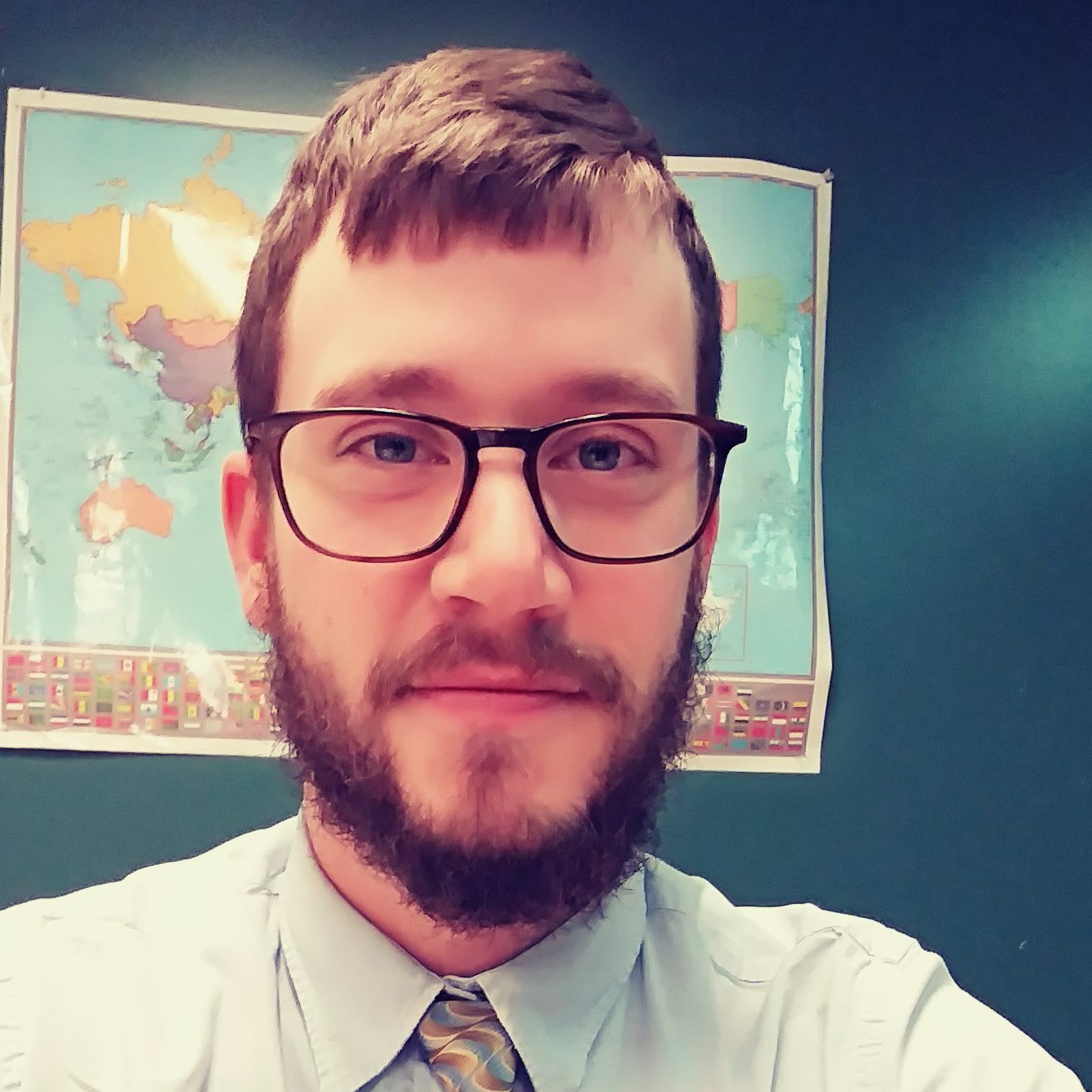
The lesson Reconstructing the South: A Role Play is excellent for exploring the Reconstruction time period. Too often, periods of American history like this one are presented without relevant connections to today’s world, which make our not-so-distant past seem like ancient history to young learners.
The role play offers students the opportunity to see the importance of the time period: how much help formerly enslaved people needed, how formerly enslaved people were offered opportunities like never before, and how the country had the opportunity to make major changes in equality and civil rights. This has led to discussions about today’s racial issues of police, the justice system, employment, housing, etc., and, as a result, I have been able to open discussions on issues relating to federal powers versus states’ rights when it comes to civil rights. This is a wonderful lesson that I plan on using again and again.

I had a wonderful experience with the Reconstruction Role Play activity when teaching Reconstruction to my Race and Membership elective. The elective itself is about developing Race Relations throughout US History, from the origins of slavery to the present day. We look at a number of issues, but Reconstruction and its aftermath is a central element to the course. Because I teach in Memphis, I also encounter many students who have never really studied this period of history and among many of their families, the “Lost Cause” myth of the Confederacy is alive and well. This becomes very clear when we’ve held discussions about the role of Confederate Statues, how we memorialize certain periods in our history, and how we look at and come to terms with the history of our city and region.
The Reconstruction Role Play was very helpful in getting my students to the point where we could analyze the lives of those most affected by the events of this era. Stepping into the shoes of former slaves and white southerners, wrestling with the interactions between these groups, wrestling with the conflicting interests of these groups, and evaluating why Northerners eventually washed their hands of reconstruction efforts helped my kids begin to see this period for what it was.
I also supplemented this resource with materials from the Equal Justice Initiative, the documentary “13th” on Netflix, and readings from the Facing History and Ourselves Reconstruction textbook. I think that this time period is an essential history for our students to confront, especially in light of various current events. From incidents of police brutality, persisting mass incarceration rates, and the use of the death penalty and prison labor to the rise of white supremacy, the Charlottesville riots, and growing inequality across our nation, our kids need to know about the roots of these issues more than ever before.
Reconstructing the South: A Role Play absolutely helped to enhance our understanding of the Reconstruction Era. While I have always spent a fairly substantial amount of time teaching Reconstruction, this lesson brought in new information both for me and my students.
Events from this era typically come up all throughout our year as we discuss civil rights and how Jim Crow Laws and segregation took hold for such a long time in our history, so when given the chance to look back on what freedmen could have done differently, many students, I would say the majority of students, wanted to demand the full distribution of land from the government. I think many saw it as a way to right the wrongs and try to change history for the better.
What I appreciated most about this activity is that it created more questions for my students as we finished up. They began to think about just how challenging this time period was and I think gained a better understanding of why this era needs to be studied closer and revisited throughout our year of U.S. history together.
The role play was an excellent way to get students to consider the complex issues and questions facing the country and freedmen at the end of the Civil War. I gave students the “Problems” questions on day one and told them that the next day I would not be guiding them, and they would have to decide how to conduct the proceedings.
It was fascinating because they quickly decided to arrange the desks in a circle and started discussing a format for their discussion. It evolved into a co-chair system, with one person introducing the question/issue and the other facilitating the discussion. They decided to vote after some debate. The facilitator summarized the discussion and then conducted a vote. Afterward, I assigned some reflection questions on goformative.com.
One student comment indicated how useful this exercise was: “It was difficult to come to a specific consensus. For instance, we can all agree on punishing Confederate leaders but agreeing on HOW to punish them is very difficult. Freedmen and women had been excluded for centuries, and people don’t like change. It is very difficult to accept such a change like that.”
This captured the ambiguity and complexity and uncertainty in addressing these issues. They showed a keen awareness that resolving some of these issues was going to be longterm.
“Reconstructing the South: A Role Play” allowed for many of my students to enter into a simulation in which they could employ historical thinking. The simulation allowed my students to empathize with the plight of newly freed slaves in the United States. While many of my students started the simulation timid, they became empowered with their new status as freedpeople. Several students chose very moderate positions on the postwar questions and status of former slaves and ex-confederates. If I did not have any students take a hardline approach to ex-confederates, I intervened, and many students joined in the idea of harsher punishment for them and greater freedoms for the newly freed people.
Through this exercise, students gained a greater understanding of the historical implications of issues unresolved from reconstruction. Students carefully listened to multiple perspectives and articulated their own views in gaining rights as new citizens. Coupled with an excerpt from “Lies My Teacher Told Me” students have explored viewpoints and perspectives that they may not have previously discovered.
I used Reconstructing the South: A Role Play for the first time this year.
It was gratifying to see students’ insights shift, and to witness them grappling with hard choices – not unlike the experiences of newly Freedmen, who didn’t always make the choices that Northern politicians thought they should.
Read more comments from teachers about the lessons on Reconstruction.
The People vs. Columbus, et al.
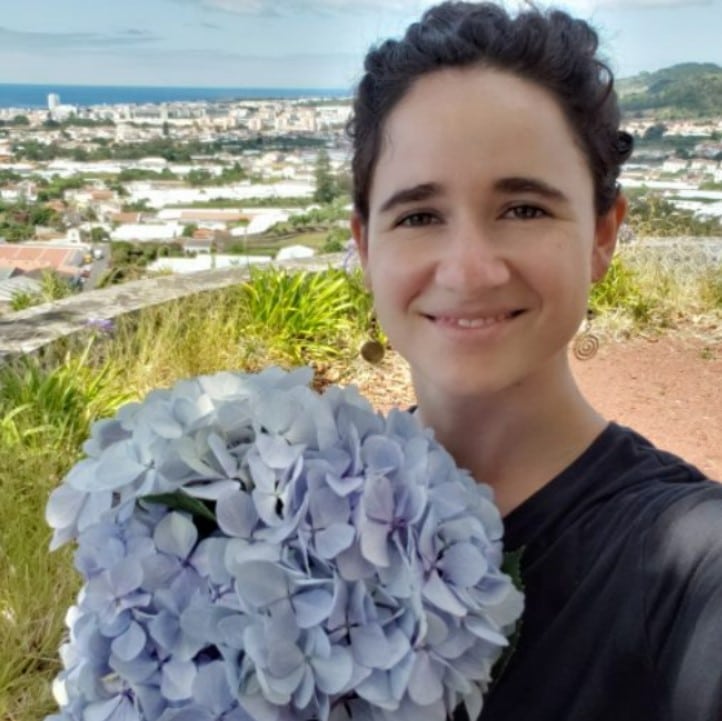
The People vs. Columbus trial has been my most successful and popular lesson in the two years I taught it. Not only do students get to learn the extent of the atrocities committed by Spanish colonizers, but they get to engage in higher order thinking (one of my grad school buzzwords I think about a lot!) on the factors that cause historical atrocities to occur.
I LOVE how “the system of empire” is one of the options for students to blame or defend. This has generated some of the most challenging discussions I’ve seen in my class so far, as students say, “The king and queen would not have sent Columbus if they hadn’t been acting within the system!” and retort, “But the system is made up of individuals, and each have their own choices!” This thinking about structure vs. agency is a level of thinking in social studies that was not made explicit to me until college, and I am thrilled that this assignment has given my students an opportunity to delve into core disciplinary questions.
They get excited about it, too ― I’ve had students leap up in the trial, hollering their positions to each other in attempts to convince a jury of their peers. At the end of the trial this year, as the jury came back with the verdict, one of my students reflected, “I think that Columbus is like Trump, and the Tainos are like the Mexican people…” This prompted a discussion about how colonial-type oppression works in our current society, leading one student to observe, “You know, I think WE live within a system.” I asked them if they thought that they had any agency within the system, and they had a really thoughtful conversation about it.
Your resources truly fill a well left dry – not by forgetfulness, but by the same racist systems that perpetuate the injustices my students face on a daily basis in schools.
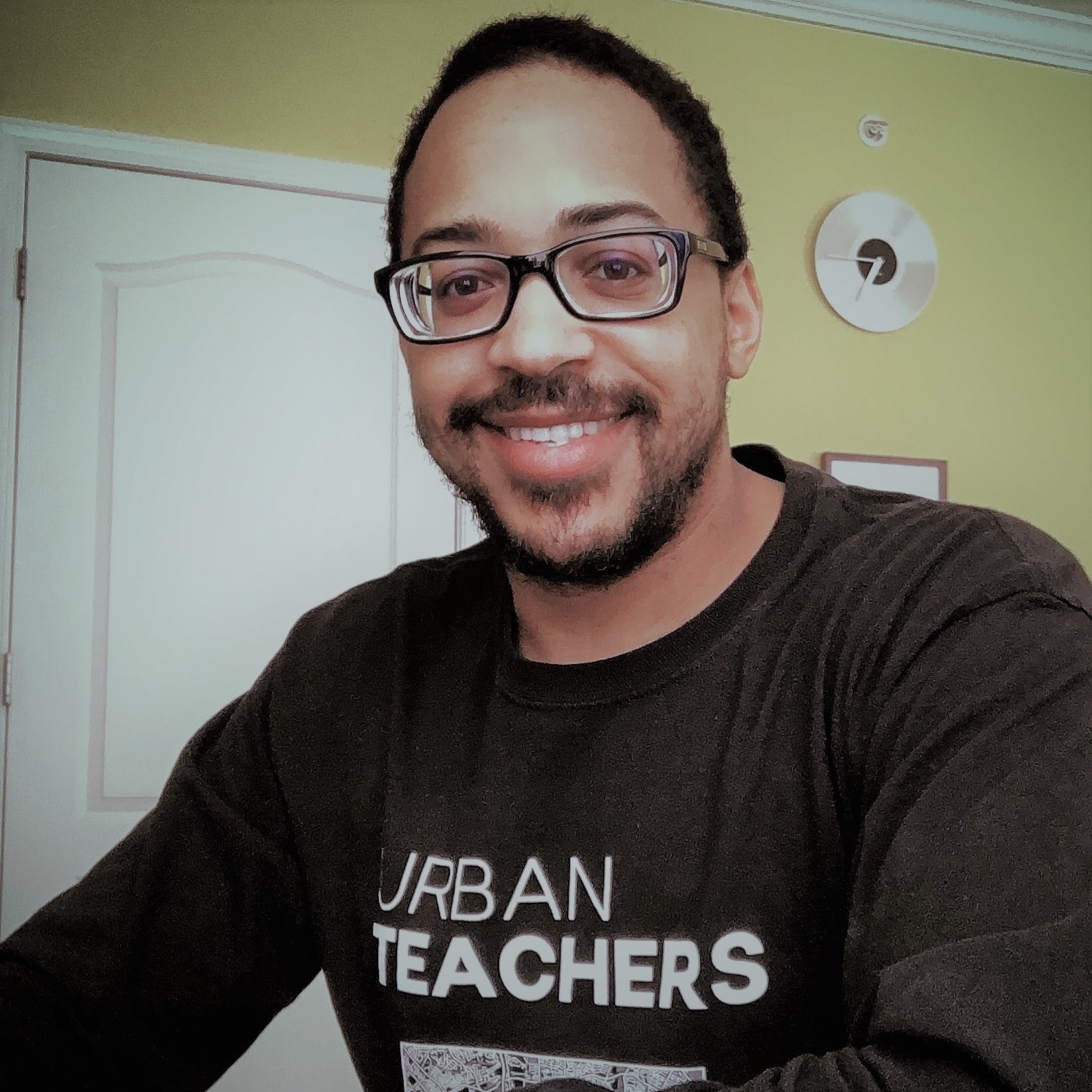
The Zinn Education Project made untold history come to life for students working on the People vs. Columbus tribunal. Students were immersed in building background knowledge by reading the indictments, working together, and using teacher-created graphic organizers to build a defense and a strong prosecution.
The lesson captivated the attention of my students in the online environment, fostered collaboration and highlighted rigorous writing, reading, and speaking & listening standards as we work our way through a delicate piece of history that not many know and everyone should appreciate.
Students remarked at the end of the first day in trial how fun and engaging the work was and how much they were learning by working together, interacting with the teacher and rereading the indictments to write argument pieces to present to class. Seeing the students produce quality work aligned to standards and related to our curriculum content is a magical feeling for a teacher and I for one am humbled it happened in my classroom.
I am grateful I had robust materials to use, a guide for instruction, and the opportunity to create. I am eager to continue to use more Zinn Education Project resources with my students in the future.
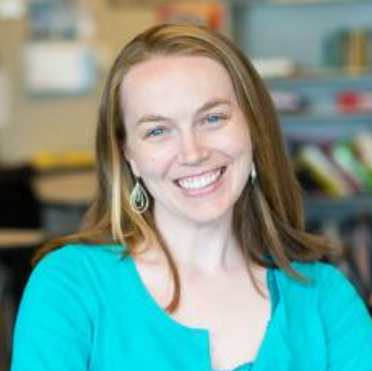
The science teacher told me that students were arguing during lunch about The People vs. Columbus et al. trial and who was to blame. This was the first time all school year he has heard students really talking about what they were learning outside of class time. To hear ninth graders thinking critically about how much of a person’s action reflects individual choice vs. what society compels them to do and then applying that to major events in world history is amazing. Thank you, Zinn Education Project.
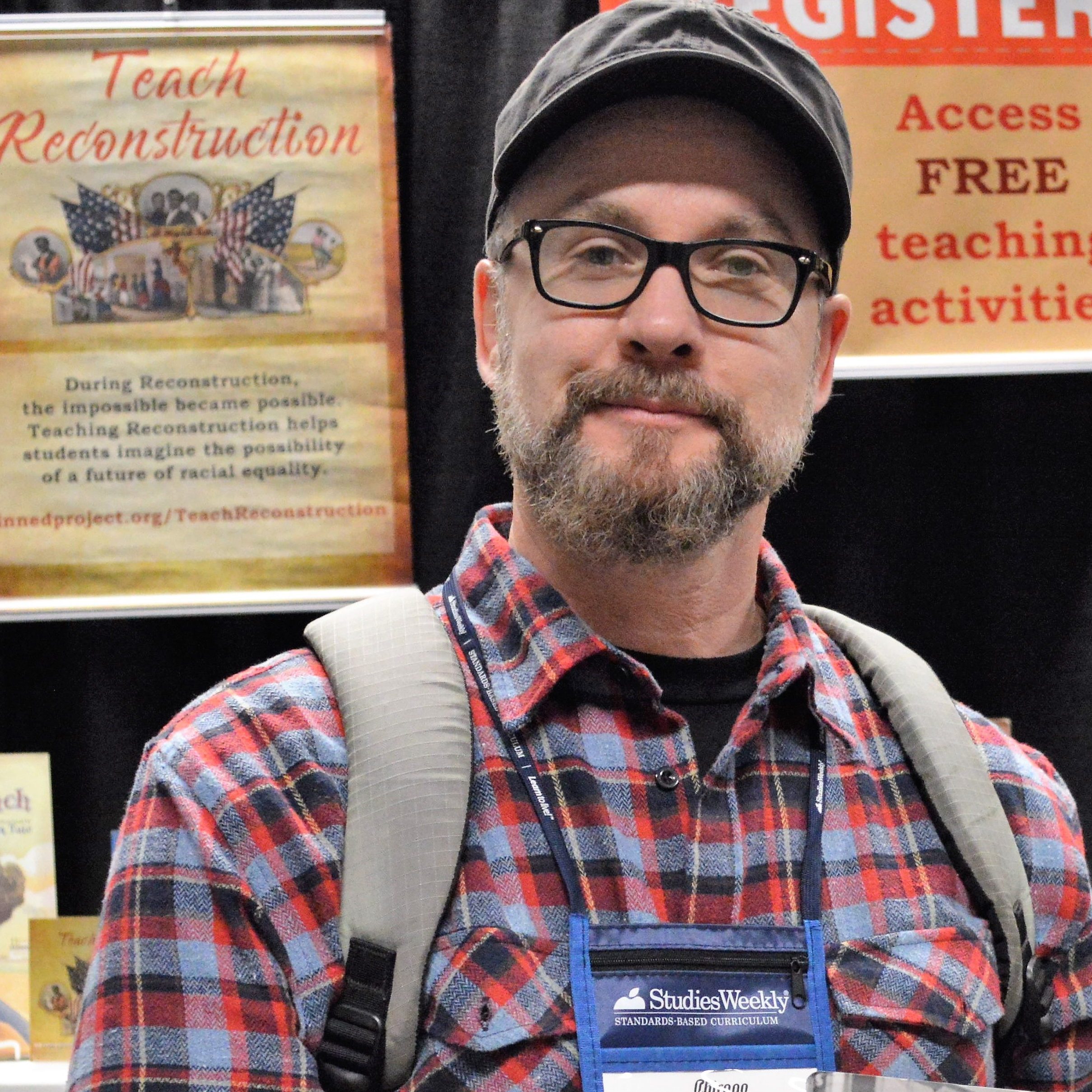
The People vs. Columbus is a great way to begin teaching about U.S. history!
Students enjoy the trial activity, learning about what happened and deciding who was responsible for the destruction of the Taino culture. It captures their interest in history and gets them thinking about current issues.
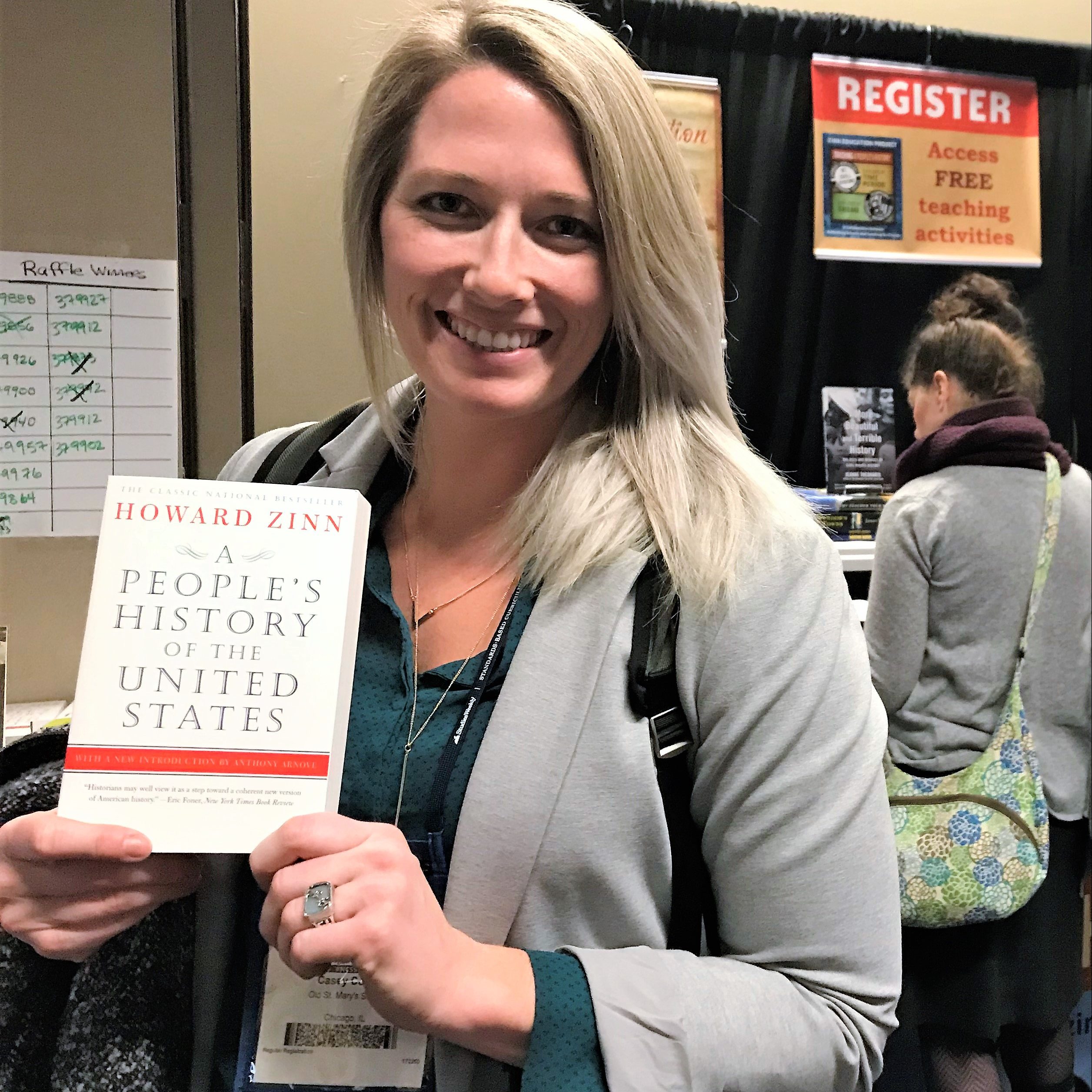
Columbus Day brings up a lot of hard questions in my 7th grade social studies classes. The People vs. Columbus lesson provides an avenue to open that conversation up with students.
More teacher voices on The People vs Columbus
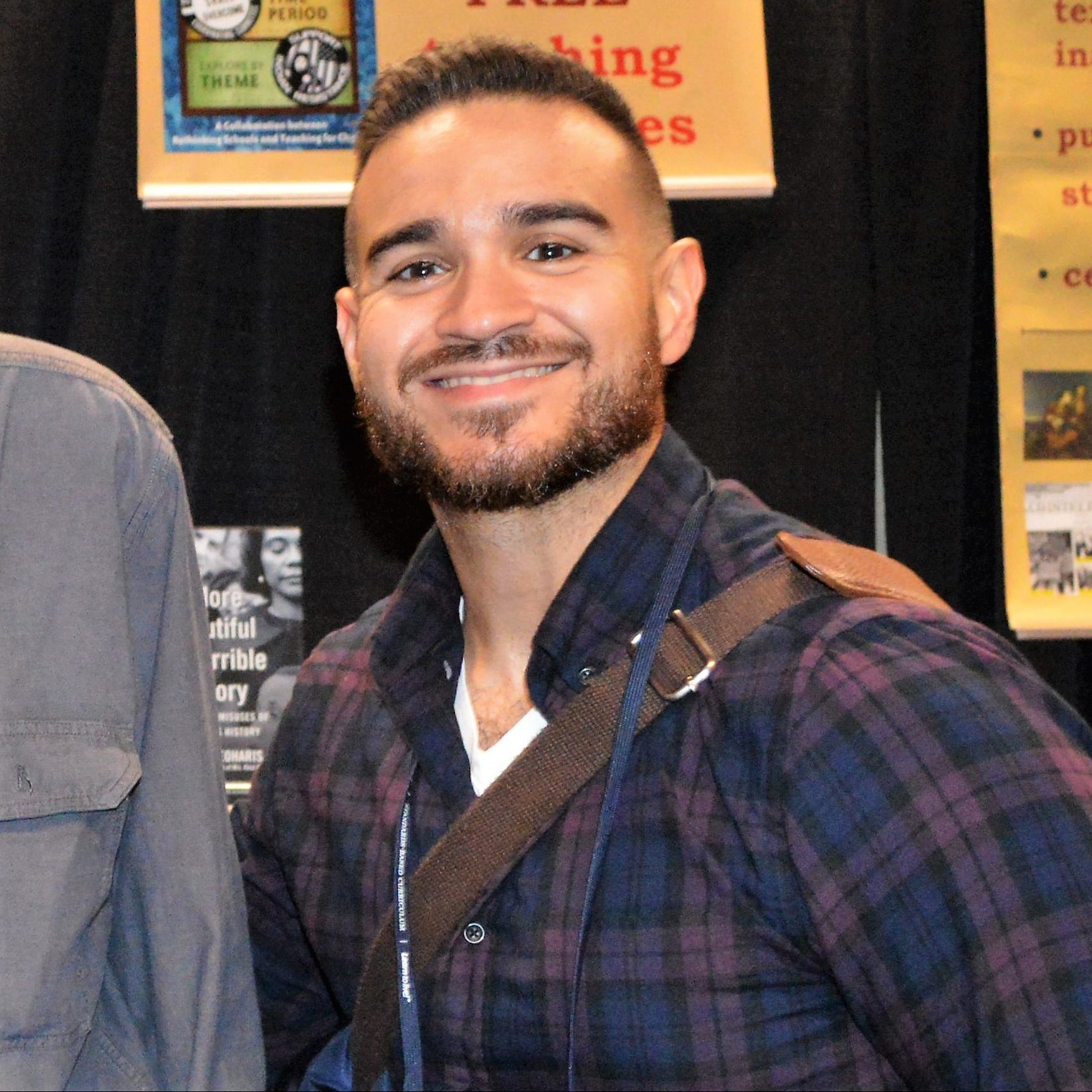
I dedicate a unit to Christopher Columbus, after a unit on the various Indigenous groups that existed before his arrival, and use The People vs. Columbus lesson.
Our overarching question is “What should be the legacy of Columbus?” Overwhelmingly our students usually decide that King Ferdinand and Queen Isabella and Columbus were most responsible for this genocide.
Students who struggle to write are most engaged and excited to share their ideas when we’re using Zinn Education Project lessons.
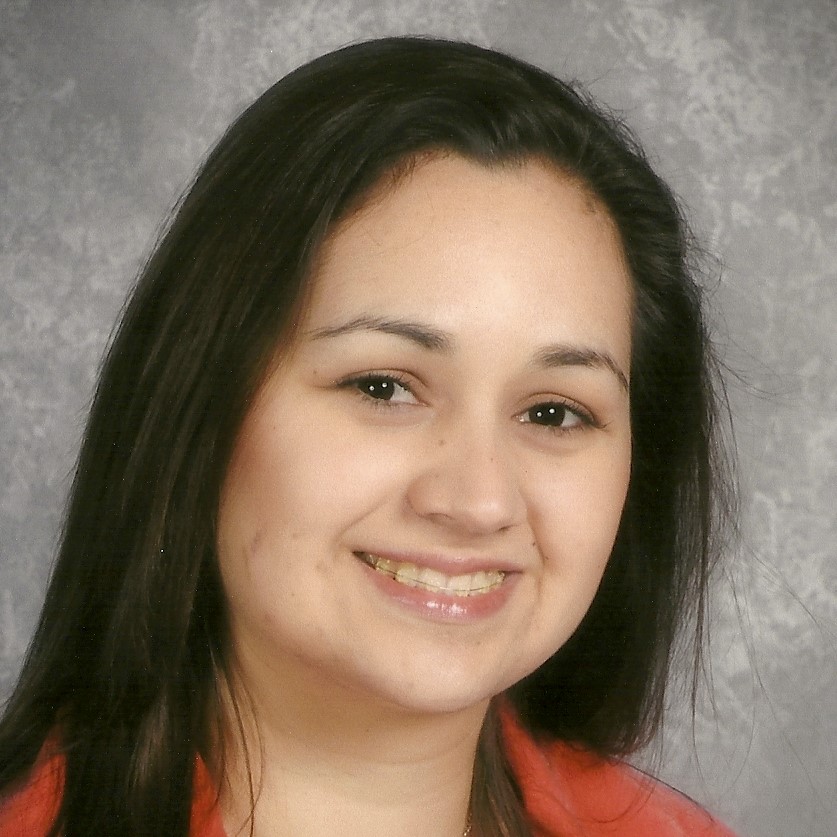
I always begin my U.S. history course with the People vs. Columbus, et al Trial. It is amazing how engaged students become to not only learn the truth but also be able to defend themselves using the evidence provided. Students love creativity and this case allows students to come to their own conclusions.
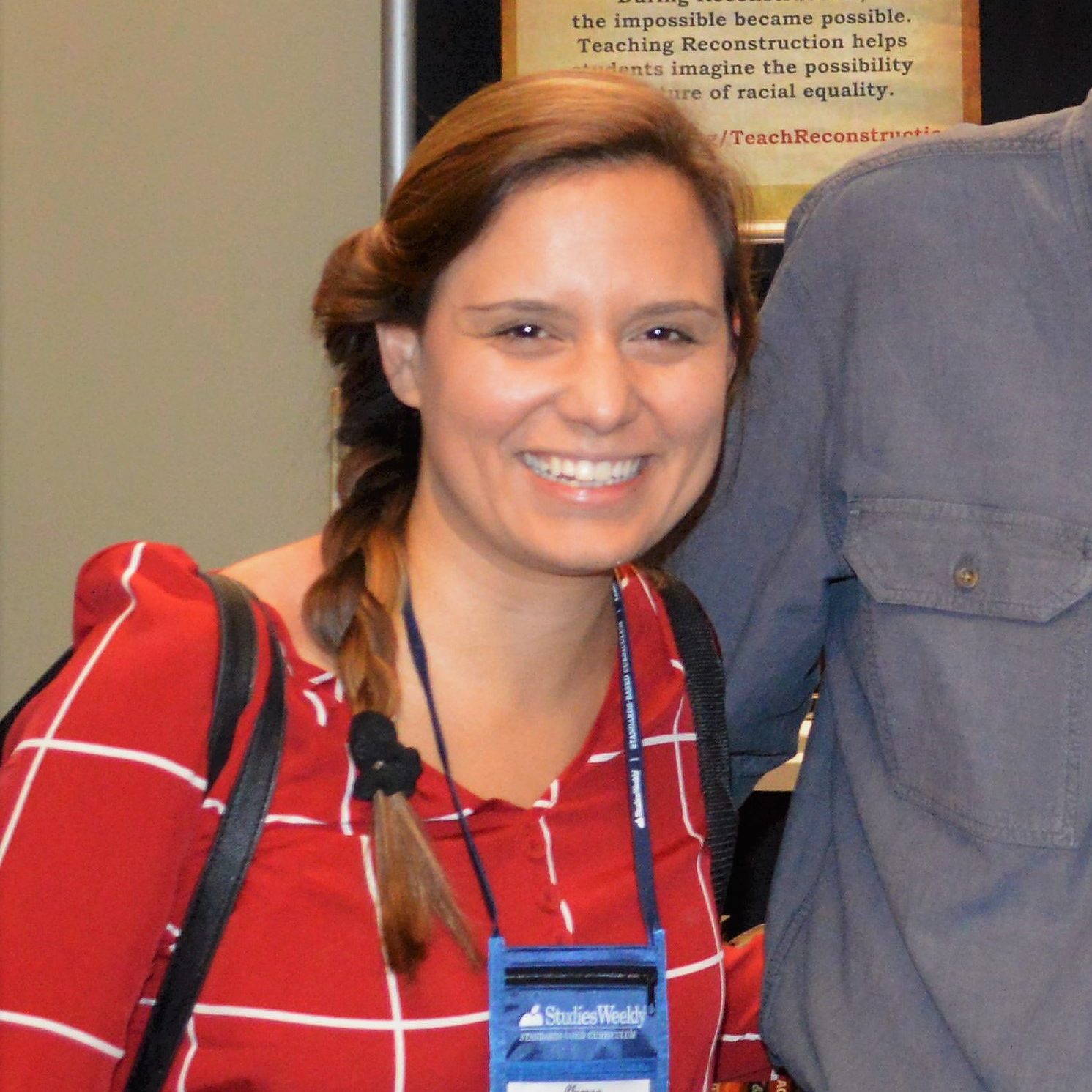
In my 8th grade history class, it is not an exaggeration to say during the People vs. Columbus activity is the most engaged my students are all year. Real, conceptual learning and content retention happens during the block.
I used the Columbus Trial activity in my methods course with preservice elementary school teachers. It went great, and they loved it!
Despite being high school graduates, my students had never heard of the Tainos or thought of Empire-building as the main actor in history.
The People vs. Columbus lesson was transformative in my classroom. Students were initially motivated by the competitive aspect of the lesson in trying to “win” during the trial. During the preparation of this lesson, students were able to really practice historical contextualization by looking through various points of view.
Additionally, I supplemented this lesson with primary sources from Voices of a People’s History. Working with the primary sources provoked deep discussion about why certain points of view are omitted or de-emphasized in American History. We compared Las Casas to Columbus and discussed the development of racism and ethnocentrism.
On the day of the trial, students were completely engaged in the process of argumentation, viewing history (in many cases for the first time) as more than just fact, but a series of arguments presented through various frameworks. By the end of the trial, it was clear that blame was very difficult to lay on just one group. It encouraged them to think more critically about a complex web of contingencies that all led to the genocide of the Taínos. They were engaged through the entire unit, practiced presentation skills, research, historical argumentation, and more.
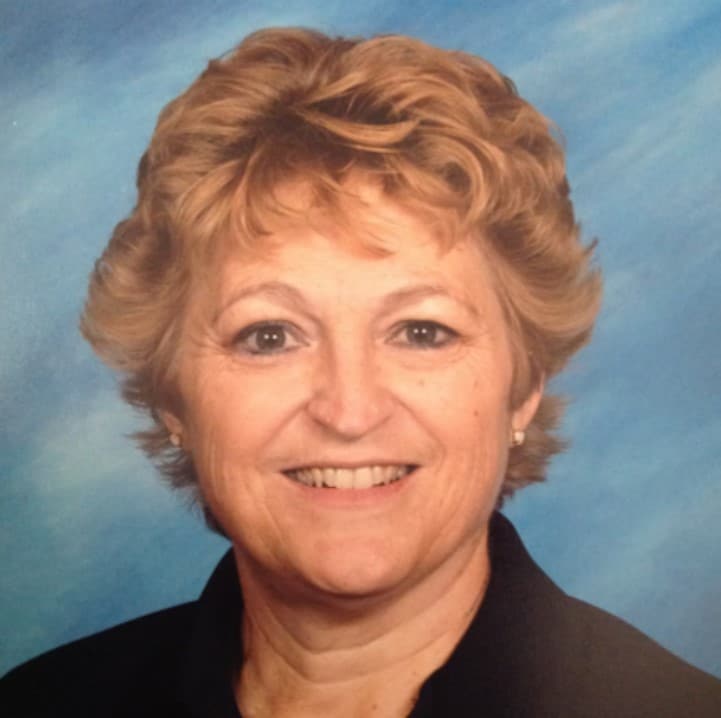
When I used The People vs. Columbus last year, the students were absolutely energized! The students had a great desire to prepare strong, convincing arguments as we put Columbus on trial. Every student in the class was engaged, which really says something about the strength of the lesson! Even the more quiet and shy students were able to take part and enjoy becoming involved. Students commented that they had never thought of Columbus and his exploration from the various perspectives before participating in this lesson activity. Many students also commented how much fun it was, and that they wanted to do something like this again in the future. I appreciate how this lesson enabled the students to develop communication, collaboration and critical thinking skills, which are essential in today’s world. I teach in an International Baccalaureate School, and examining events and ideas from multiple perspectives is the key to understanding other cultures and becoming internationally-minded. Thank you so much for sharing engaging activities and lesson plans for students.
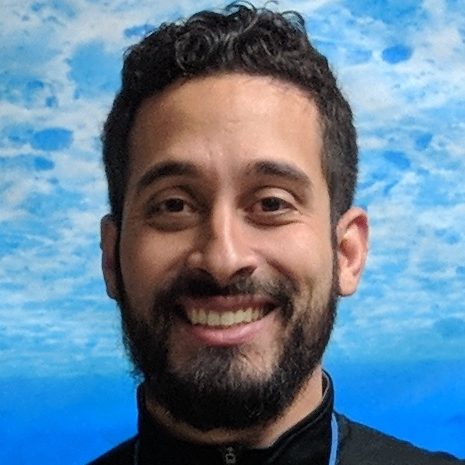
The impact from The People vs. Columbus resource is multifaceted.
The level of engagement and rigor that this activity can bring about in my students is unmatched by other activities for studying the time period during which Europeans first began to arrive to the Americas in the 15th and 16th centuries. Over the years, I have been able to continue to add primary and secondary sources to enhance this activity and make the conversations richer and deeper. Each year, I invite administrators and teachers to observe the trial. Here’s what some teachers have had to say about the activity:
I was astounded at the high level of tasks, thinking, vocabulary, and procedures…It truly made me reflect on what I’ve been assuming is “7th grade level,” and what 7th graders are actually capable of.
It was clear in the proceedings that this was no fluffy activity in which students joked about Columbus with little actual background knowledge. Rather, I observed a rigorous level of preparation on the part of the students, highlighted by them quoting primary source documents from Columbus’s era.
During the full-class courtroom proceedings, then during the Jury deliberation that I observed in the room next door, your students were passionately, wholeheartedly engaged. They referred back to their notes feverishly, conferred with colleagues, and were excited about and invested in the proceedings. During the witness questioning and closing statements, student-generated orations were stirring.
I believe that the way in which ZEP pushes students to understand history through a critical lens has made my classroom more engaging, more rigorous, and has prepared my students to be the types of citizens this world desperately needs.
My students were completely engaged in The People vs. Columbus trial we held about the massacre of the Taíno people. They loved it! They were so outraged that Columbus Day is a federal holiday that I suggested we send letters to the editors of local newspapers and our city council. They were so excited. Most of the students chose to send letters. When a student’s letter was published the next day advocating for our city to celebrate Indigenous People’s Day, the students who had not yet sent letters immediately began to write their own.
It was a powerful lesson in civics, especially since my students are disenfranchised and feel like they don’t have power to effect change politically.
When I do the Christopher Columbus lesson, the students are blown away. They are usually so surprised at the truth behind Columbus. They also love the role-playing. This year, when I was doing the lesson, my assistant principal walked in just as one of the students who usually sits quietly during social studies was standing up and asking a fiery round of questions to the defendants on the stand. I was so impressed with it. The lesson also gets students who I usually don’t get a lot of participation out of to debate with the students who I do. I love it!
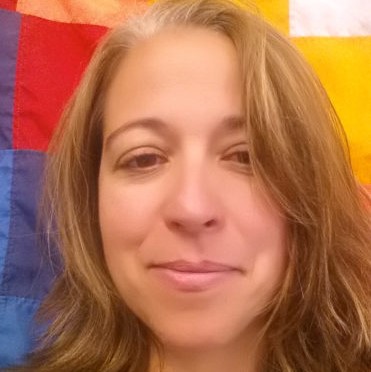
The People vs. Columbus trial was so effective. I taught it in a Native American Studies course and the students spent a lot of time exploring primary source documents from Columbus and Las Casas.
It was powerful to watch them transform into excellent and passionate litigators, but basing their arguments upon historical evidence. Also, the power of role plays to induce empathy and compassion for various points of view was evident.
My students are all Native American and they are all too familiar with the concepts of genocide and exploitation. However, many of them did not know about the Taíno and were curious to learn more. At the conclusion we watched the film Even the Rain to enhance their understanding of the texts, and also to learn more about the Cochabamba water war to piece together an interdisciplinary unit about water that they were engaged in.
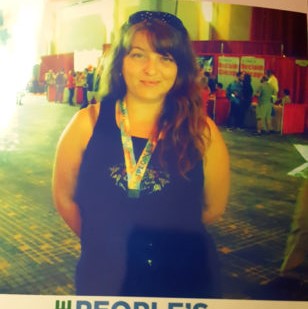
The Christopher Columbus trial is a phenomenal lesson to use with students. First, it forces them to think about the construct of our globalized world in a new and critical manner. Americans are bred upon the unchallenged idea of superiority and equality, and it is troubling for them to have to see that the true pillars of trade, colonization, exploration, and expansion are instead rooted in forced inferiority and exploitation. This lesson further challenges students to give up the stereotypes and nostalgia surrounding Native Americans (in this case on Hispaniola) and see them as people who had functioning societies and belief systems. The most powerful aspect of the lesson, however, is the way it forces students to research, utilize primary resources, think in a debate-like manner, and justify their positions with evidence.
One of my students returned to visit me last month to inform me that because of partaking in this lesson last year, he joined an online group advocating the end of Columbus Day. I was impressed to have a 10th grade student not only take a firm stand on something, but actually take action to incite change. Another of my students said that this “was the best lesson I ever learned because it helped me believe that there is ‘real’ history I can learn from.”
I use the People vs. Columbus resource annually in my 7th grade classroom.
My students love it and find it very engaging. I always invite other teachers to serve as a jury and they are always impressive.
I’ve used Rethinking Columbus two times now in different institutions. The impact has been great. For both cases, I used the People vs. Columbus, et al. trial activity — one at a graduate institute and the other at a youth organization. Both instances had the participants, ages 17 to 30, invested in the trial and who they were representing — shedding more than just a light on the holiday weekend (as this activity was done just after Columbus Day). More specifically, it provided space for a specific participant to open up about his Taíno background. The activity got a lot of love.
Read more comments from teachers about the Columbus trial role play.
Constitutional Convention Roleplay
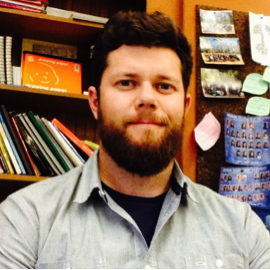
I use Zinn Education Project lessons because they are high quality, get students to do critical thinking, and allow them to examine history from multiple perspectives. Having my students engage in the U.S. Constitutional Convention role play is always a highlight for them, as students get to actively relive history and begin to develop historical empathy.
Through using the Zinn Education Project lessons, my students are beginning to see and understand how the inequities of the past were constructed and then they are able to start making the connections to today’s inequities in society. It is from this understanding that we continue to work to try and figure out how to change our current world, based on our knowledge of the past.
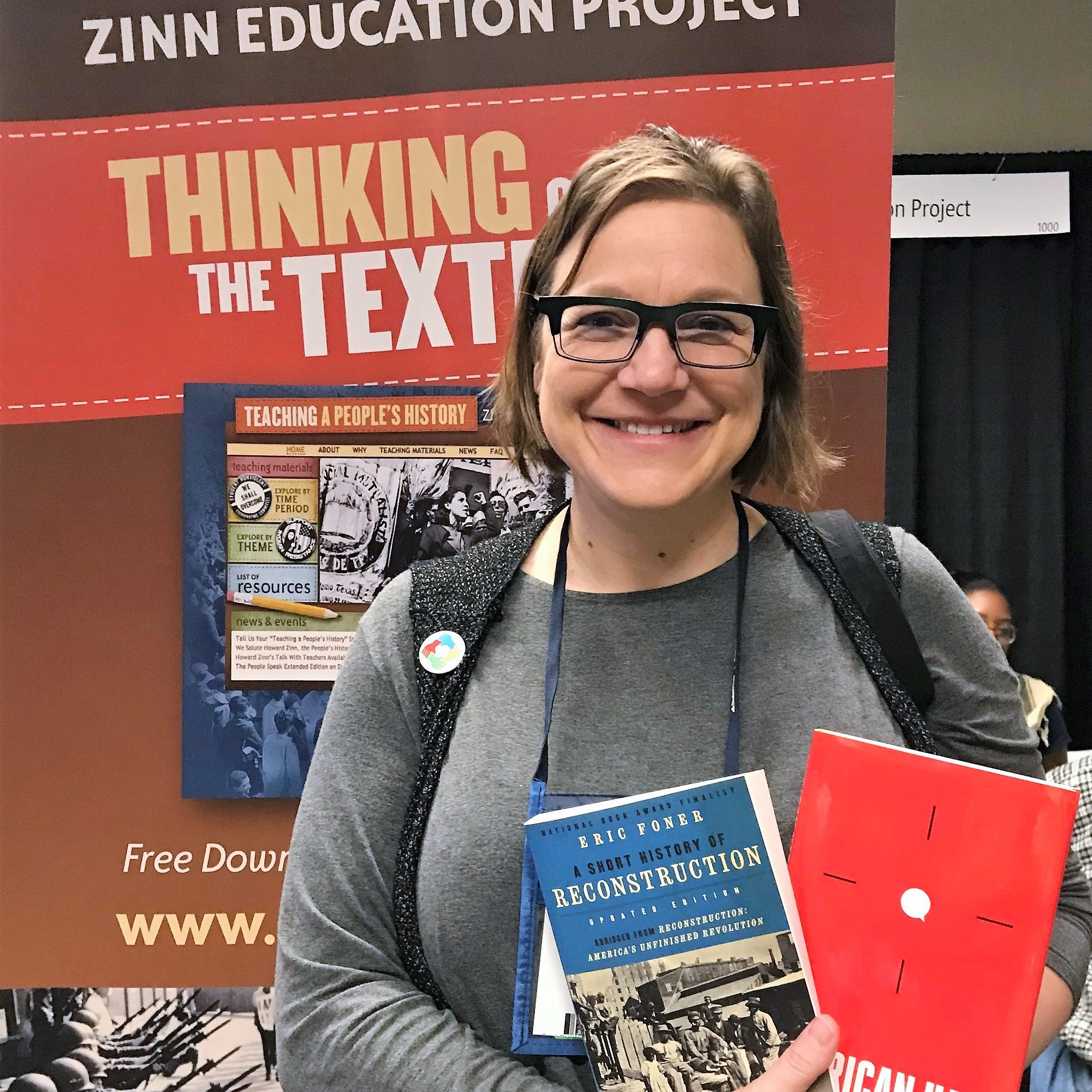
The Zinn Education Project has delivered time and time again the most impactful experiences for my students. They will not remember the PowerPoint info on the Articles of Confederation, but they will remember when they wrote the Constitution from the perspective of an enslaved African American or a member of the Iroquois nation using the Constitutional Convention role play.
They understand the problems embedded into the way our country was founded AND the remarkable opportunities we have to reshape the conversation in our nation.
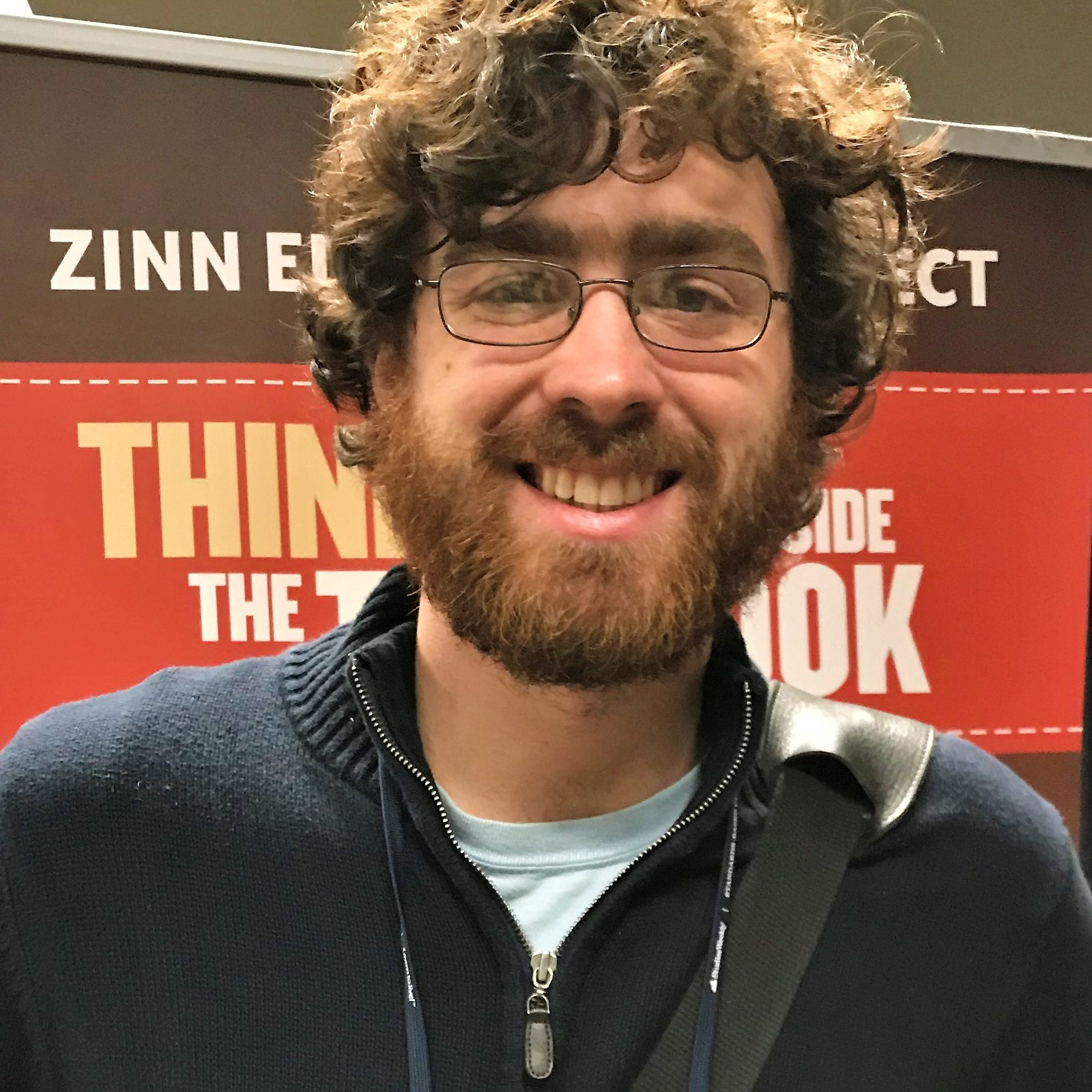
I use the Constitution Role Play lesson in my classroom as a hook for a larger unit, in tandem with Teaching Tolerance’s unit “Did the Constitution establish a just government?” The students were very engaged during the activities and created a much more just constitution in our role-play. Really appreciated the resource.
Read more comments from teachers about the Constitutional Convention role play.
U. S. – Mexico War
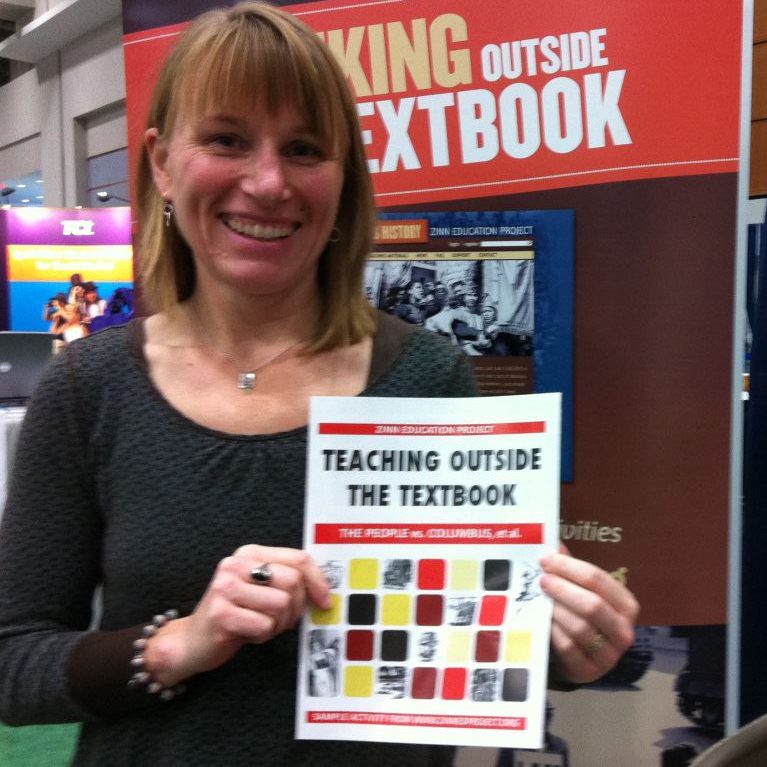
I received the Zinn Education Project materials and I immediately flipped through the book and taught the U.S. – Mexico War lesson. It was so wonderful to see a group of usually unmotivated students engaged in the lesson that I called in another teacher to see this group of students actively involved in the activity.
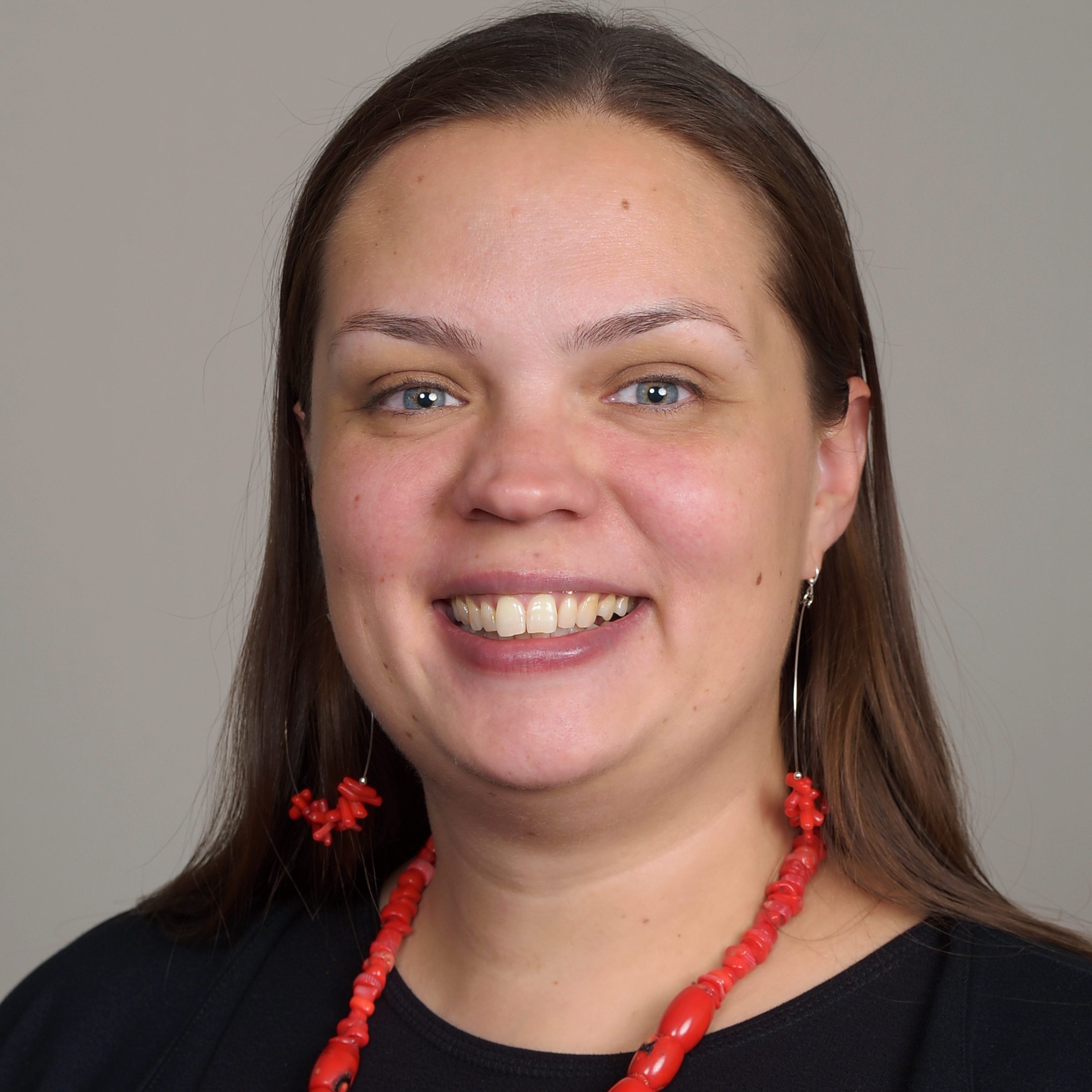
I use lessons from the Zinn Education Project because they are relevant, factual, and inspiring. Lessons like The U.S. – Mexico War shed light on aspects of our shared American heritage that are often overlooked. These lessons give a voice to great Americans who are too often forgotten.
Even though my students don’t quite understand it yet, I can see that a close examination of people’s history empowers my students to use their own voices.
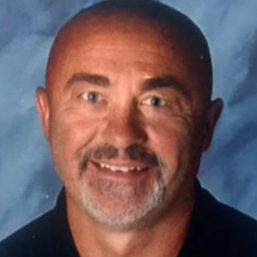
I teach at an inner city school, an incredibly diverse school. The lesson on the Mexican American War and the role play are incredibly effective in helping students understand the role of racial bias in the history of U.S. Foreign Policy.
Students really appreciate the opportunity to read and reflect on Zinn’s chapter, and appreciate different points of view about the war during the role play. My Latino students appreciate the approach, one that all too often in their education has not received the attention it deserves. This lesson took on new forms and even greater importance at our school, with the organization of a Hispanic Union, and it informed our celebration of Hispanic Heritage Month and current events, like the debate on immigration policy.
Many of my 12th grade students today in Government class still look back to this lesson as a foundational moment in their learning about the history of US/Mexico relations. (They) see that the border issue today has a much longer history and wider context than they originally may have realized.
I dedicate a unit to westward expansion, and using the U.S.-Mexico War Tea Party activity has given students many perspectives on the war.
They enjoy this lesson in particular because they are able to interact with one another and teach in turn their assigned perspectives. I find that they walk away from this activity knowledgeable and excited to learn about the impact of the war.
A People’s History of the United States
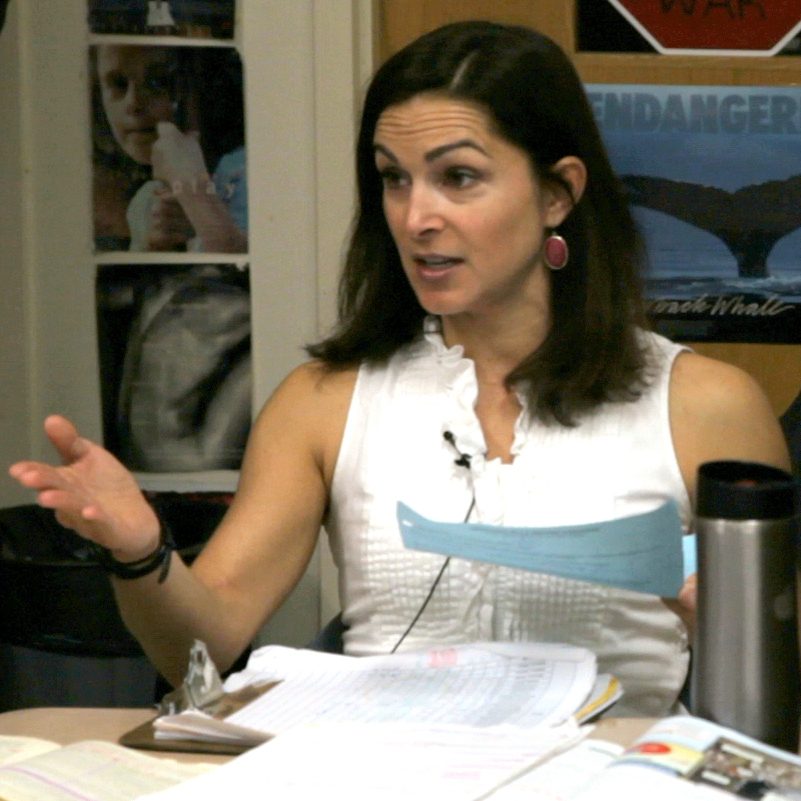
It is easy for some to lose track of WHY we teach these days and instead focus on what we are teaching. The Zinn Education Project has been so helpful to access thought-provoking resources, simulations, and role plays that I can use in my classroom to reinforce the text while also teaching social justice and citizenship.
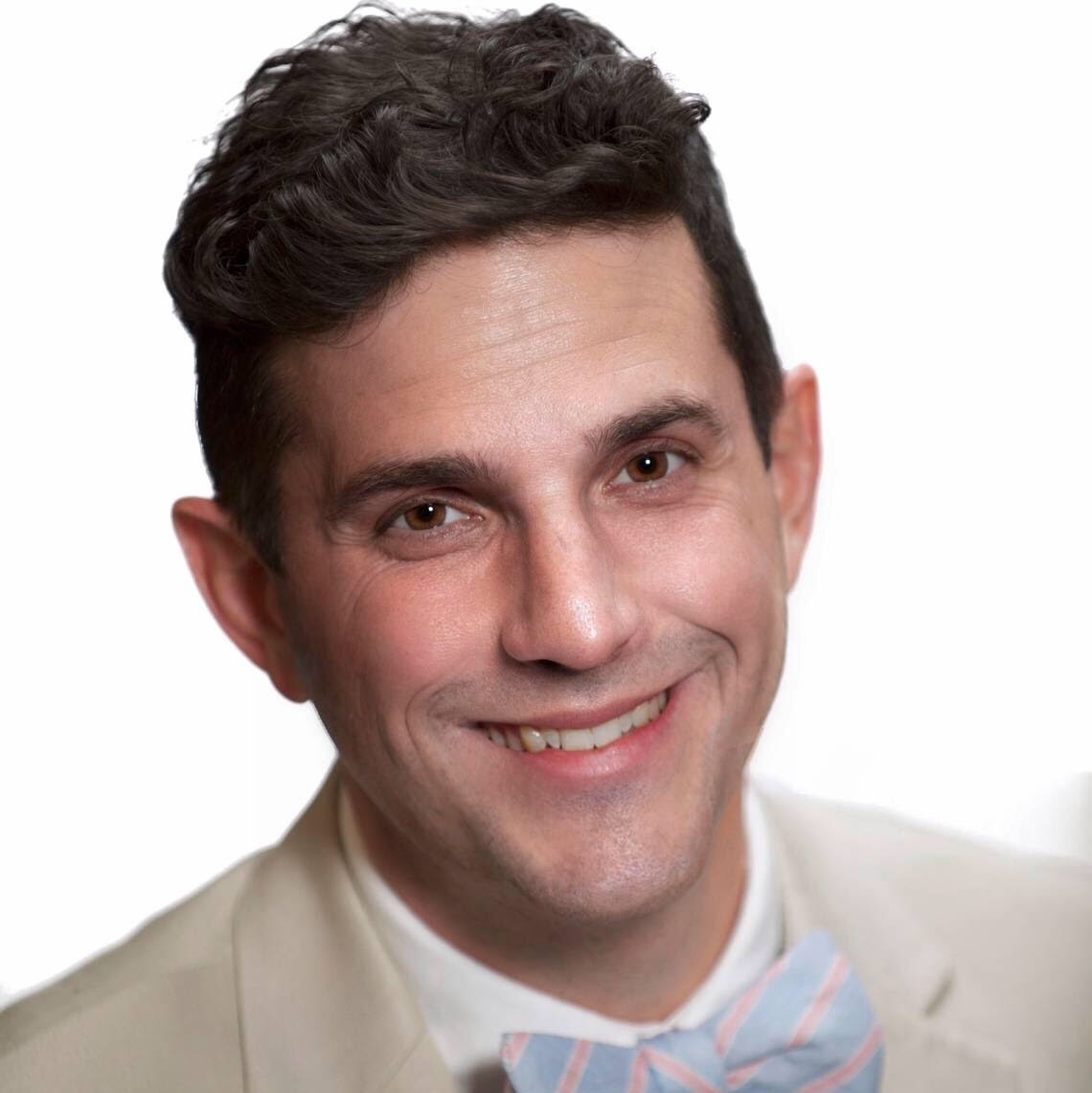
Because of this book, I understood early in my college career the importance of the true, unfiltered words of the actual actors in a historical event. As a result, I was drawn further into the study of history and, eventually, into my career as a history teacher. What A People’s History brought to my attention is that American history is much more interesting than that. Our history is an exciting, sometimes appalling, struggle for power and that makes us just like every other country that has ever existed.
A long list of “good guys” with no one to struggle with is neither a true story nor a good story. It doesn’t resonate because it leads the student to believe that we are all waiting for the next exceptional leader, instead of becoming a force for change in our own communities. A People’s History helped me recognize this as a student of history and inspires my attempt to bring true stories to young people, weary of the inaccessible lists that history teaching has become.
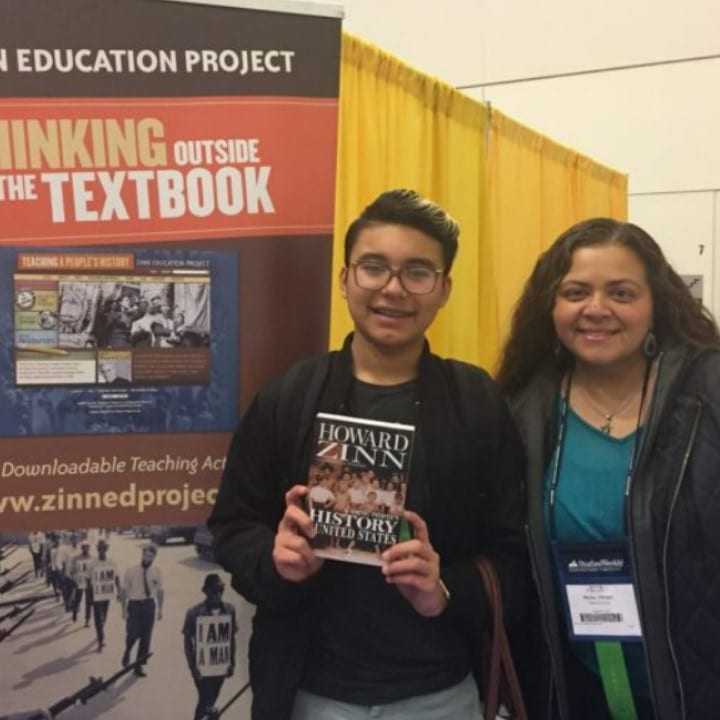
I am an 8th grade Humanities teacher at Melrose Leadership Academy in Oakland.
I just finished chapter 4 of A People’s History of the United States on tyranny with my 8th graders, and I have never seen so many of my students engaged in discussion! One of my normally non-avid readers came up to me at the end of the class and said, “Ms. V, this is such an interesting book!”
I am so proud to be using Howard Zinn’s work! Thank you!
From A People’s History of the United States, I use Howard Zinn’s chapter on the U.S. -Mexico War as a starting point to teach my students Imperialism, Manifest Destiny, and Westward Invasion.
Along with the book, students read primary sources from many sources, including Lincoln and Frederick Douglass. These sources have even inspired their own anti-war protest signs.

In 1995, when I was assigned A People’s History of the United States by a professor during my first year of college, I had never read anything like it. Suddenly, the small subsection or the colorful inset of the giant textbook was getting some actual attention. The stories of marginalized and exploited groups were being given more than a blurb. In a time where the information superhighway was still only a two-lane road, I didn’t know where else to find these kinds of historical narratives.
After a decade of sweating in the service industry, I was finally able to secure a job teaching high school history. I was very excited to finally be doing the thing that I had wanted to do for so long. However, I soon was surprised to find that the “great men” narratives that had been pervasive in my textbooks were very much alive. Surely, I thought, those types of textbooks have been replaced — being more aware of historical biases, as we as a society are. From a source here and there, I was able to cobble together a few more inclusive lessons, but I knew I wanted more.
Fortunately, I recently stumbled across the Zinn Education Project. That same excitement that I once felt diving into the stories of those whose voices had not been elevated. These stories drive lessons that get students to see a broader picture than before. I continue to find new materials to add to my class, and I will continue to do so for years to come.
Reading Zinn’s A People’s History of the United States as a freshman in college solidified my desire to study history. I was enamored by the book’s passionate prose and its unwavering condemnation of the crimes of the U.S. government. I was equally shocked by the fact that almost none of it was taught in my U.S. history class; it felt like I was reading something forbidden or scandalous, which kept me interested and engaged. Whether conscious of it or not at the time, reading through it with that lens surely also inspired me to study education later on.
This Day in History series
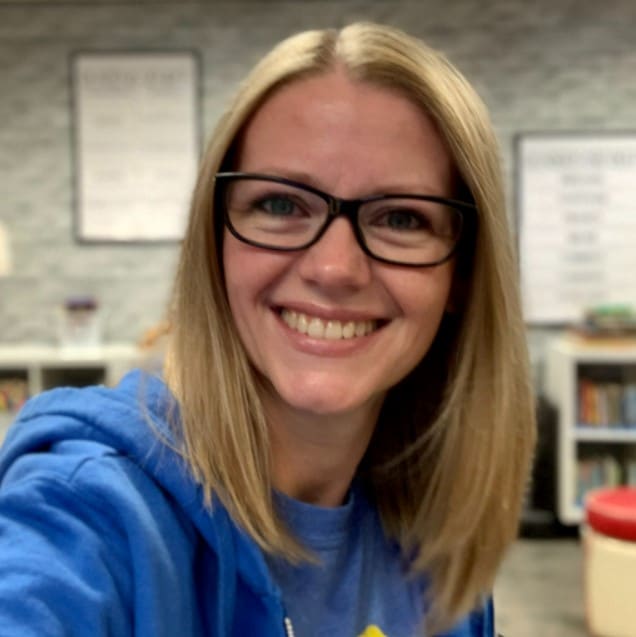
I love your This Day in History series. It inspires me every time I learn about history that has impacted us. I appreciate the information, which really helps inform my teaching practice. I feel confident that I can bring accurate stories and relevant information to my classroom students about topics I was not taught growing up. You not only help me become a better educator but you help my third graders become better critical thinkers.
Most recently I was able to learn more about topics including voting rights, segregation laws, and Rosa Parks. We spend time learning about Indigenous, Black (BIPoC), and women’s rights history every year. We have big classroom research projects in February and March in which our students present information they learned.
Our Women in History presentation is a favorite project every year. Students choose a woman that has been an inspiration, or had a great impact on how things are today, and learn about their life. They then create a research project and present what they learned while wearing a t-shirt they created in class inspired by the life of that person. Thank you for your dedication to helping our world of learners.

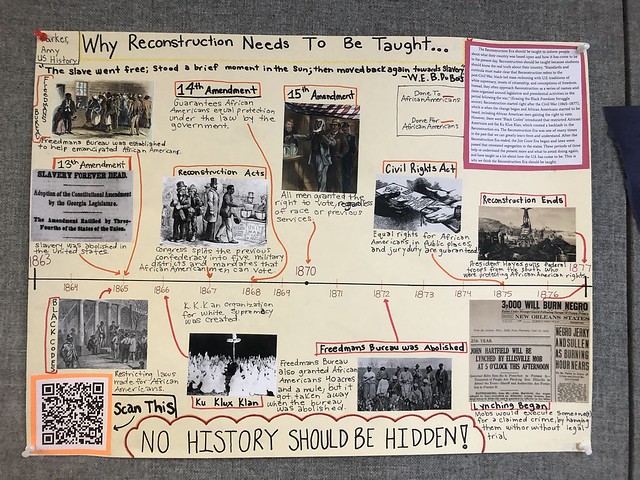





I became a historian because I picked up Howard Zinn’s “A People’s History of the United States.” The book is always within arms reach. But it’s not just the book that’s important, but the idea that history must be an active pursuit that strives for justice.
Andy Forney, Instructor, The United States Military Academy